This guide is meant to be a detailed reference on all the important aspects and features of the Grasshopper C# Script component. If you would like a quick introduction to the script component, please check:
| This guide does not discuss C# programming language syntax or the Rhino APIs. If you would like to learn how to create custom scripts using C# programming language, please check: |

|
C# Component
Let’s dive into C# scripting in Grasshopper by creating a Script component. Go to the Maths tab and Script panel and drop a C# Script component onto the canvas:
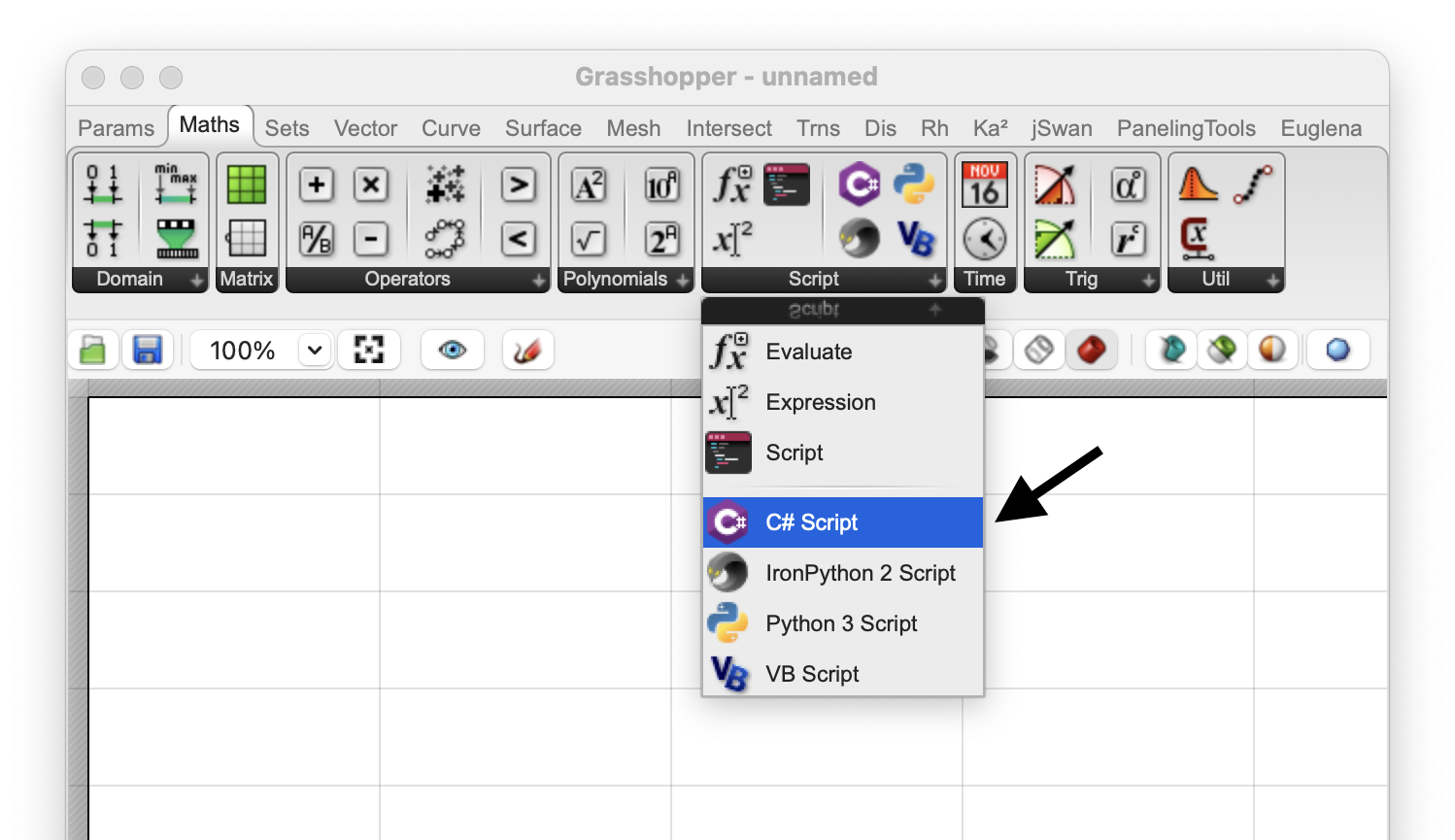
You can also use the generic Script component that can run any language, and choose C# from the [ ● ● ● ] menu:
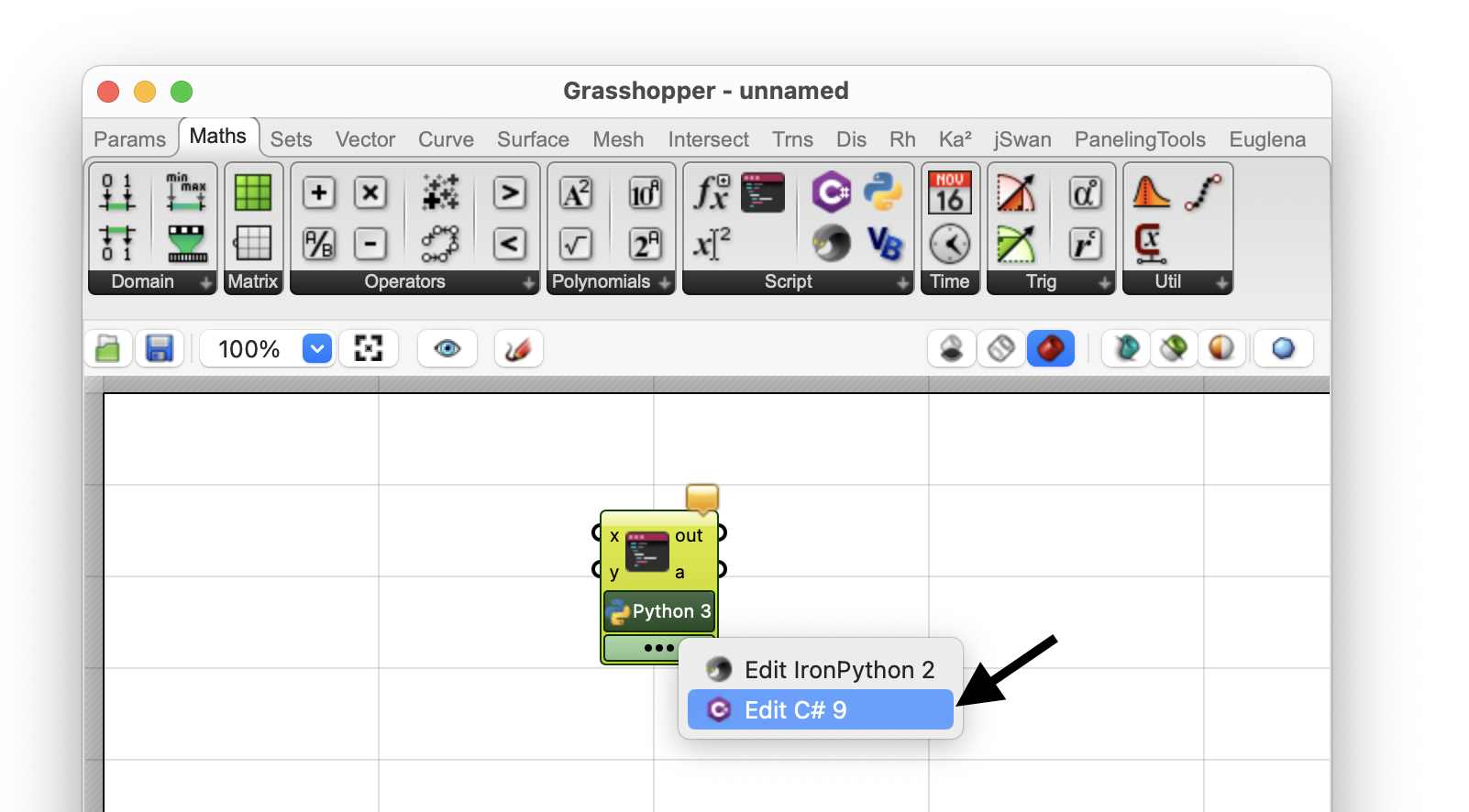
Opening Script Editor
Now we can double-click on the component to open a script editor. Note that the component draws a cone pointing to the editor that is associated with this component.
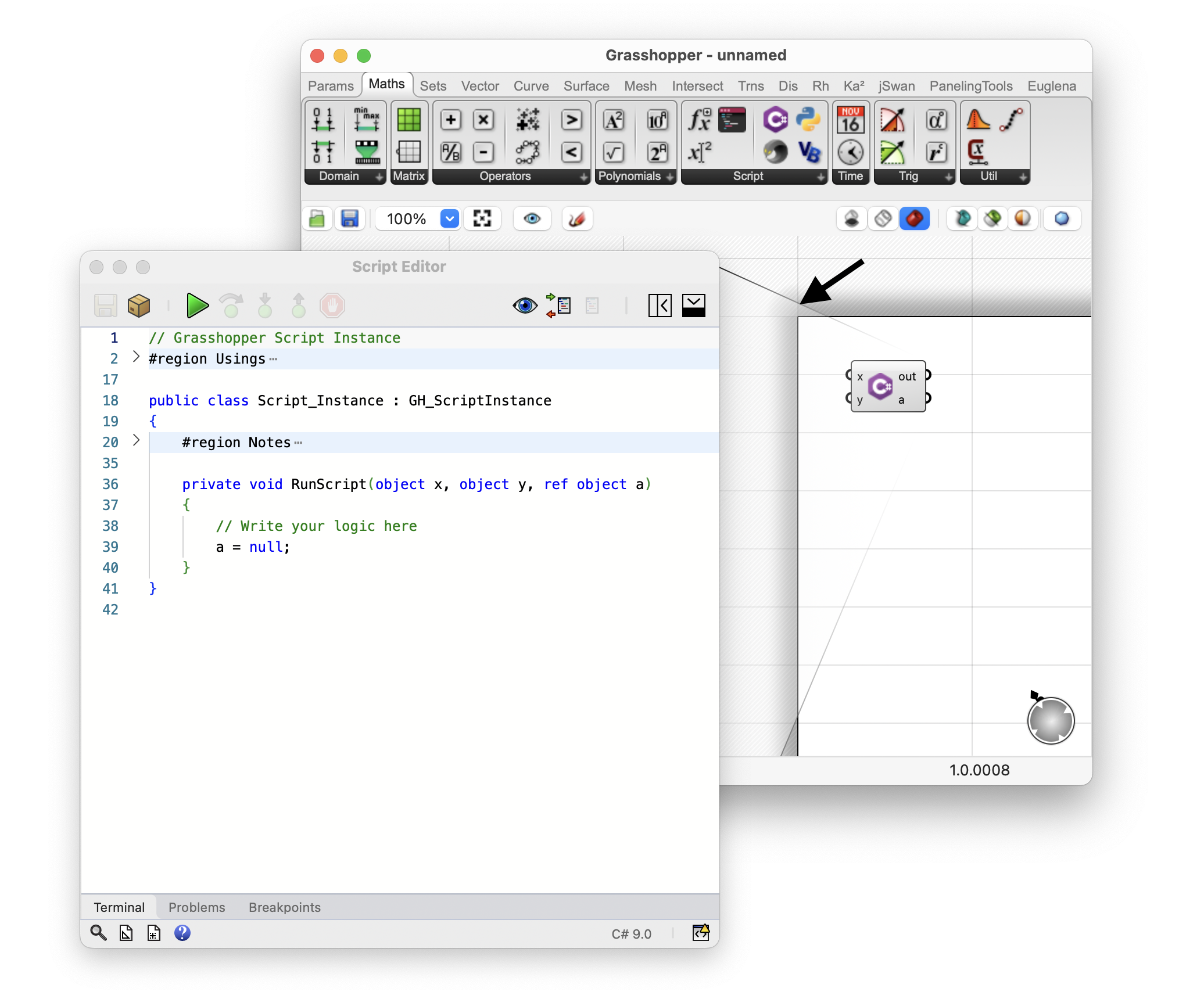
Component Options
At any time, you can right-click on a script component to access a few options that would change how the component behaves. You know a couple of them that are common with other Grasshopper components like Preview, Enable, and Bake. We will discuss all the options that are specific to this script component in detail below:
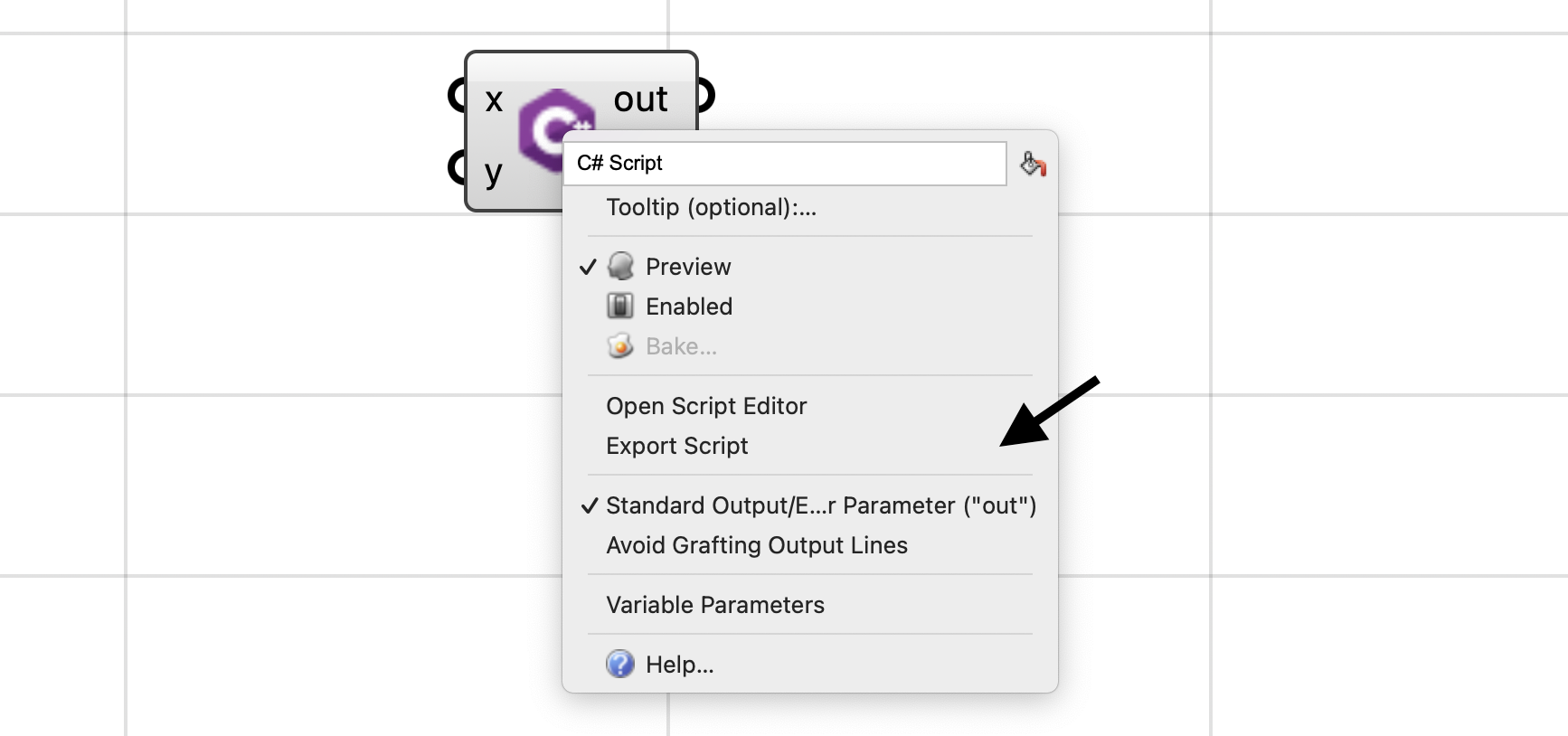
Advanced Options
An extended (advanced) flavour if the context menu is accessible by holding the Shift key and right-clicking on the component. This menu has a series of more advanced options that are needed in special cases, and are discussed later in this guide.
Script Name
Scripts in Grasshopper are not stored as files. Most often they are embedded inside script components. To name a script, we basically renamed the component itself. The script tab and breakpoints panel reflect the script name:
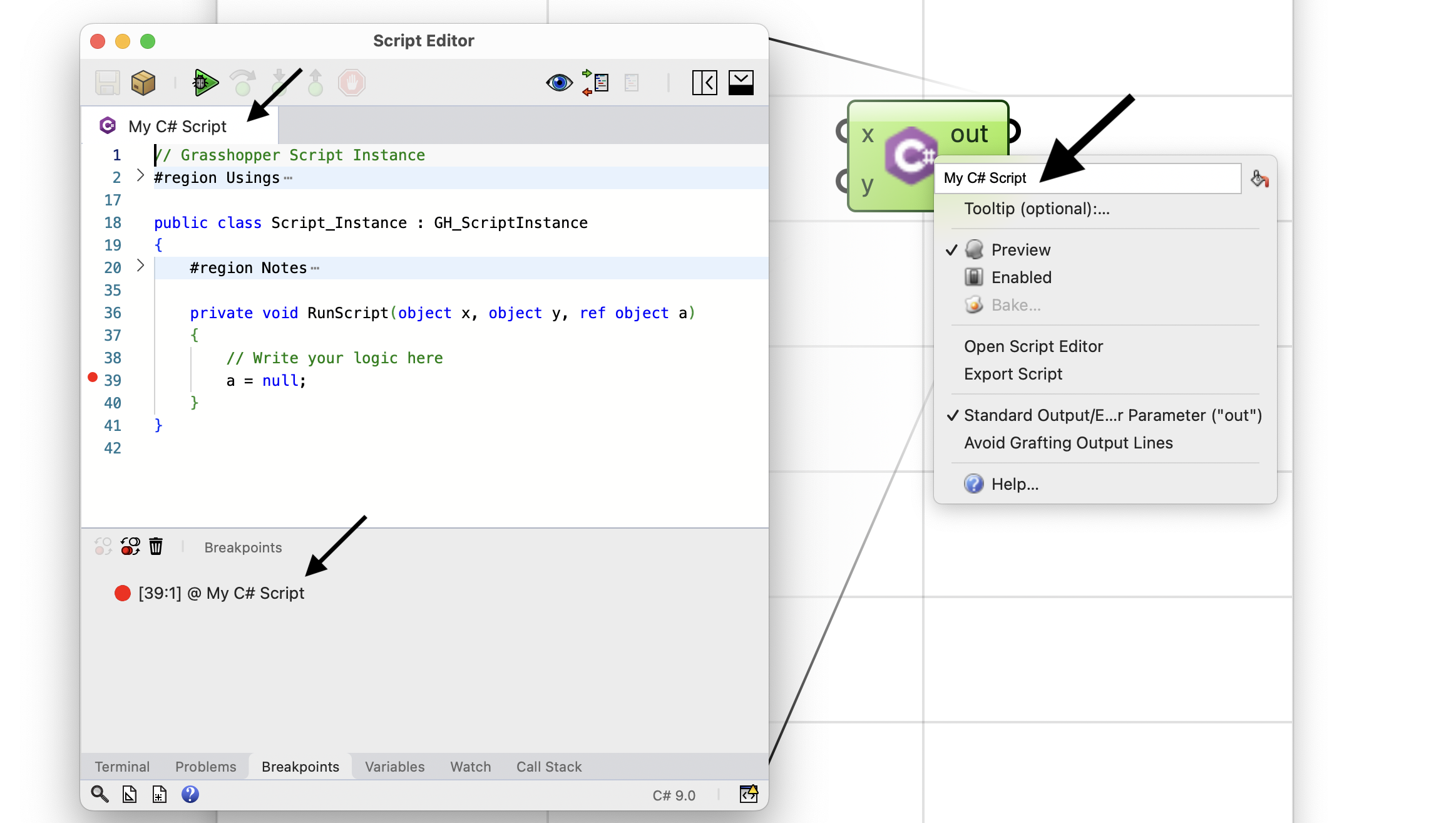
Modern C#
In C# script component, we can use a more modern flavour of C# language. It has more features that the older C# used in previous Rhino versions and also supports much simpler Script-Mode that is discussed below.
For example, String Interpolation is a one of these modern features:
int value = 42;
// interpolated strings start with $ before opening the quotation
// Each pair of {} can contain a valid C# statement. The computed result
// of that statement is converted to a string (`.ToString()`) and
// mixed into the interpolated string.
Console.WriteLine($"Value: {value}");
The script editor shows the version of C# language on the status bar:

Inputs, Outputs
The most important concept on a script component is the inputs/outputs. The Script component supports Zoomable User Interface (ZUI for short). This means that you can modify the inputs and outputs of the component by zooming in until the Insert [ ⊕ ] and Remove [ ⊖ ] controls are visible on either side:
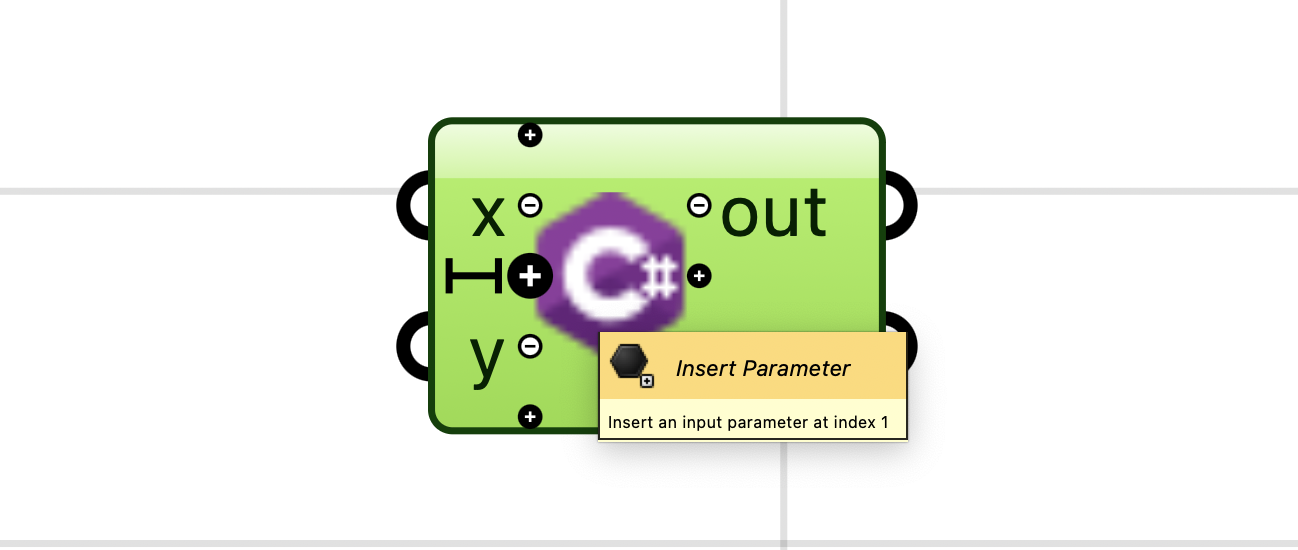
By default a script component will have x and y inputs, and out and a as outputs. When all parameters on either side are removed, the component will draw a jagged edge on that side. This is completely okay as not all scripts require inputs or produce values as outputs:

Every time you add a parameter, a new temporary name is assigned to it. You can right-click on the parameter itself, to edit the name. It is good practice to assign a meaningful name to parameters so others can understand what kind of inputs to pass to your component or what these inputs are gonna be used for.
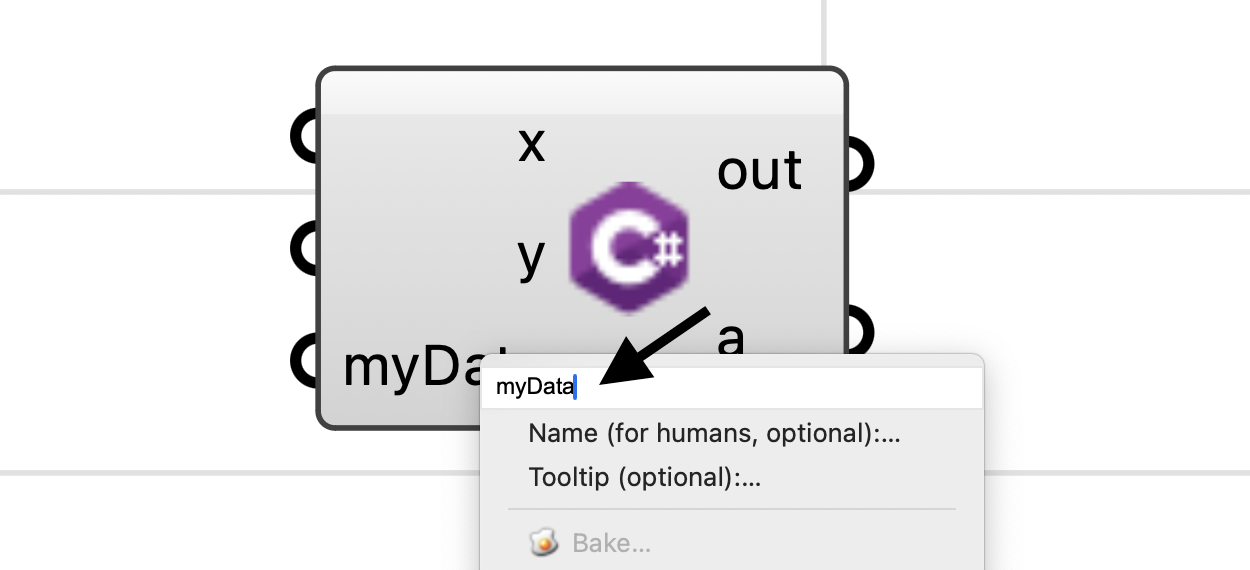
C# is a compiled language. Every time you are changing the combination of input and output parameters, or their Type Hints you C# script is updated and must be recompiled. The component will show any compile or execute error messages that might occur on the message bubbles.
A short compile delay is expected when you are making parameter changes. If you have a very large script that takes a while to compile, you can disable the Grasshopper solver when making many parameter changes.
Reserved Names
Every programming language has a set of reserved words (or keywords) that are used in its language constructs. For example in C#, the words return, decimal, or default are all reserved. The C# script component does not allow using any of these keywords for input or output parameters:

Check out C# Keywords for more information on these keywords.
Standard Output (out)
The out output parameter is special. It captures anything that the script prints to the console (Console.WriteLine). The captured output is passed to this parameter as one string or multiple strings (one for each line). The default behaviour is that each line being printed to the console, becomes one item in the out parameter:

You can control the single vs multi-line behaviour using the Avoid Grafting Output Lines. When this option is checked, all the console output will be passed as one single item to the out parameter.

Toggling Output
In case your script is not printing anything to the output, the out and be toggled using the Standard Output/Error Parameter option in the component context menu. When checked, the out parameter is added as the first output parameter. Otherwise, it would be removed:
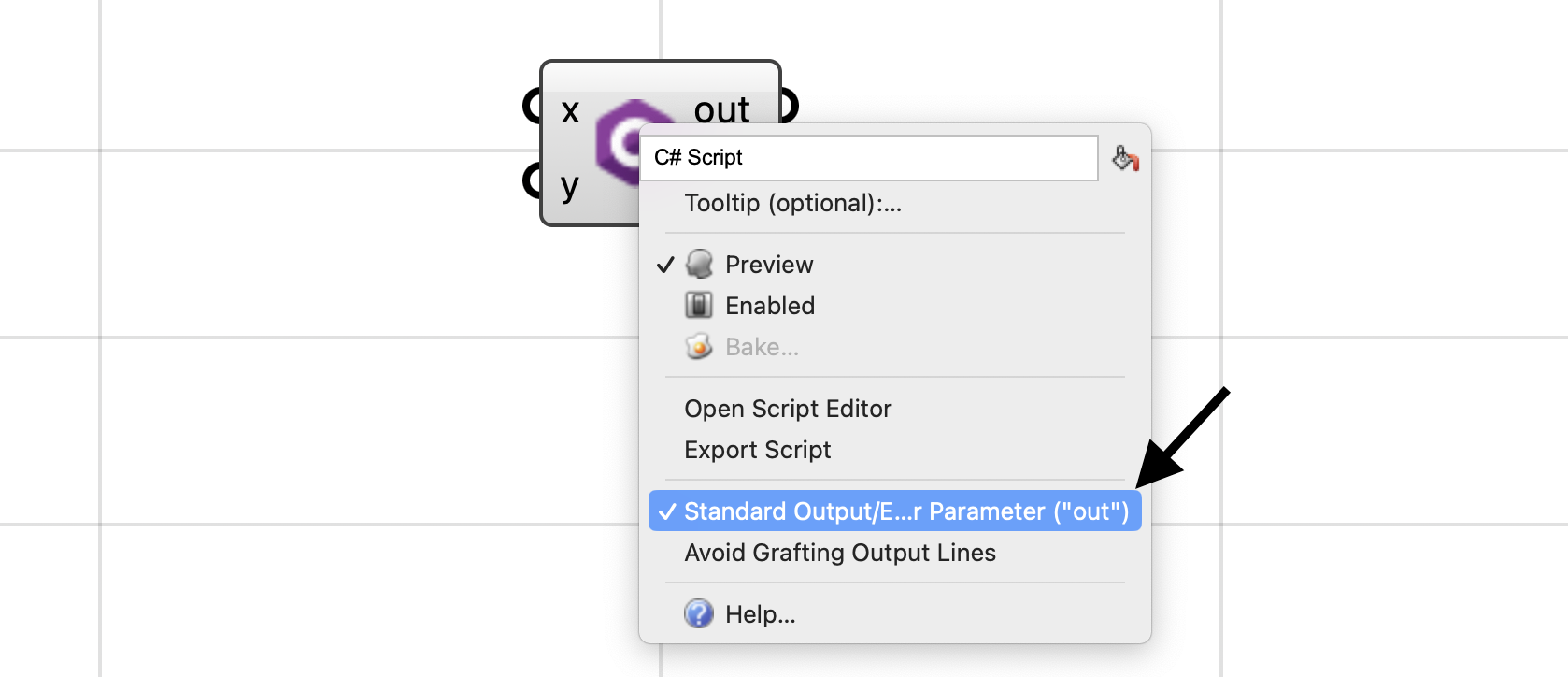
Removing the out parameter may improve the performance of your script component by a small amount, as the component will not attempt to capture the output, process (split into lines), and set the results on the out parameter. This performance increase might not be meaningful for a single component, but it would possibly be noticable in a larger Grasshopper definitions with multiple script components, each running thousands of times to process your data. Genereally it is good practice to toggle off the out parameter when unused.
Type Hints
C# is a strongly-typed language. More often than not we need to define the types of inputs and outputs to be able to use all their associated features. For example, C# knows how to add two integers (int) together, so if we are going to add inputs in the script, we would need to define a type that supports the addition.
This is where Type Hints come into play. They define the type of input or output parameter while also act as data type converters. For example you can pass a Line to an input of type integer and the converter would capture the length of the line and pass that as the integer to the component. The conversions are identical to how Grasshopper parameters can convert to each other.
By default all inputs and outputs of a C# component have No Type Hint meaning they are defined as type object in the script. This provides a lot of flexibility but if you pass two integers to the default x and y inputs, this script below would fail as C# does not know how to add two objects to each other.
a = x + y;

We can choose an int type hint for both x and y inputs to allow the addition to work in our script:
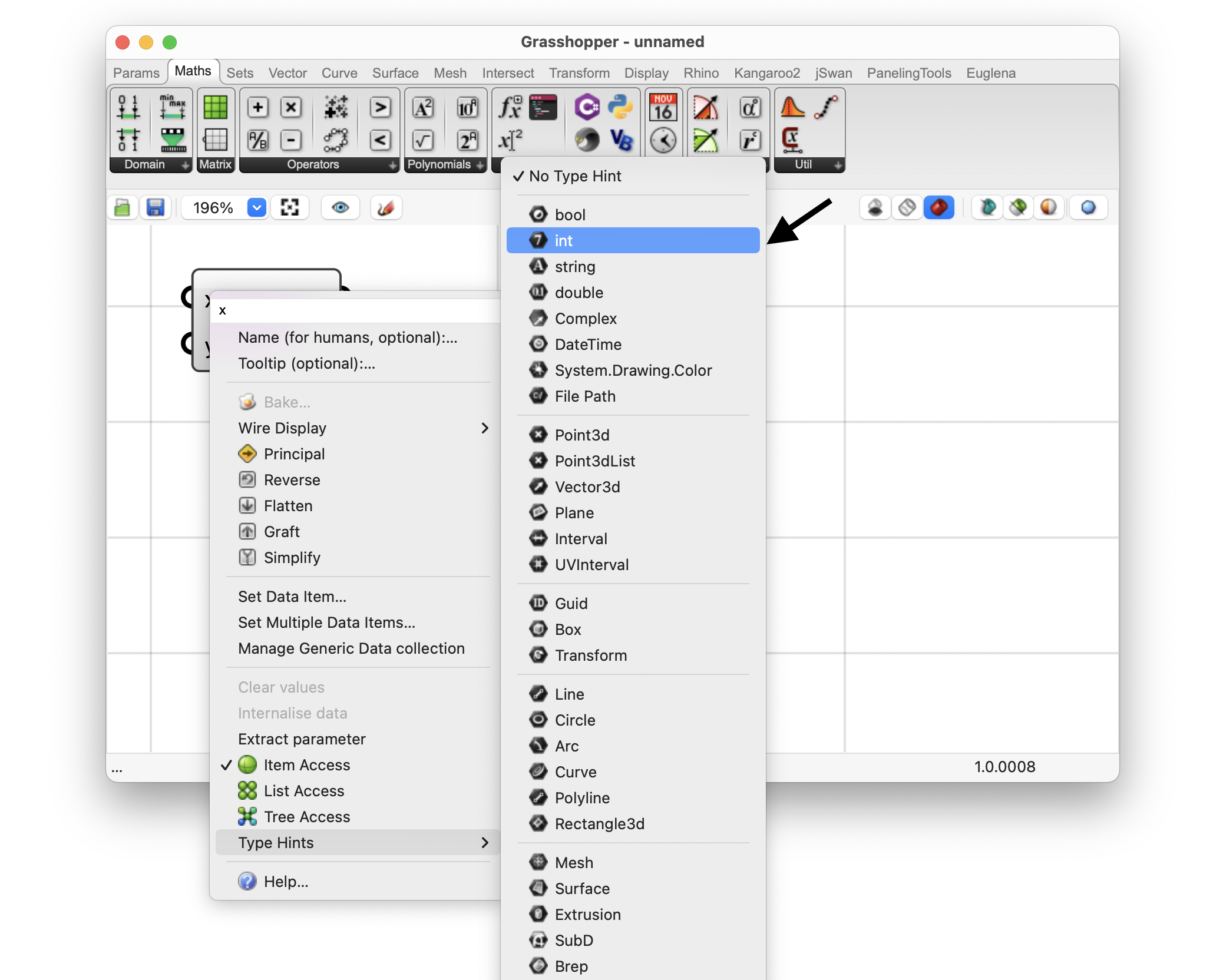
There are plenty of Type Hints to choose from. They are available on both input and output parameters.
Check out Advanced: Type Hints for more information on these type hints and their use cases.
Outputs Are Objects
In C# script component, the output parameters are always defined as object. Their associated Type Hint is only used as a converter to convert the output value to the desired type, and does not affect the data type defined in the script.
This provides the flexibility to assign any value to an output and let the Type Hint determine how to convert that to the desired type. For example, assume output value a have an int Type Hint assigned. Since it is defined as object we can assign a value of Sphere and let the Hint convert the Sphere into a single numerical value.
Parameter Access
Component input parameters have another useful option on their context menu. This feature is called Parameter Access and is part of Grasshopper SDK (GH_ParamAccess):
| Access | Description |
|---|---|
| Item | Every data item is to be treated individually |
| List | All data branches will be treated at the same time |
| Tree | The entire data structure will be treated at once |
We can modify this option on the script component inputs as well:

Here is an example of the data type passed to the script component on the x parameter, for the three access kinds. Notice, on Item access, x is set passed as an individual double representing the number value, for List access, x is set to a List<object> that contains all the number values in one branch, and for Tree access,x is set to a DataTree<object> that provides access to all branches and items of the input:
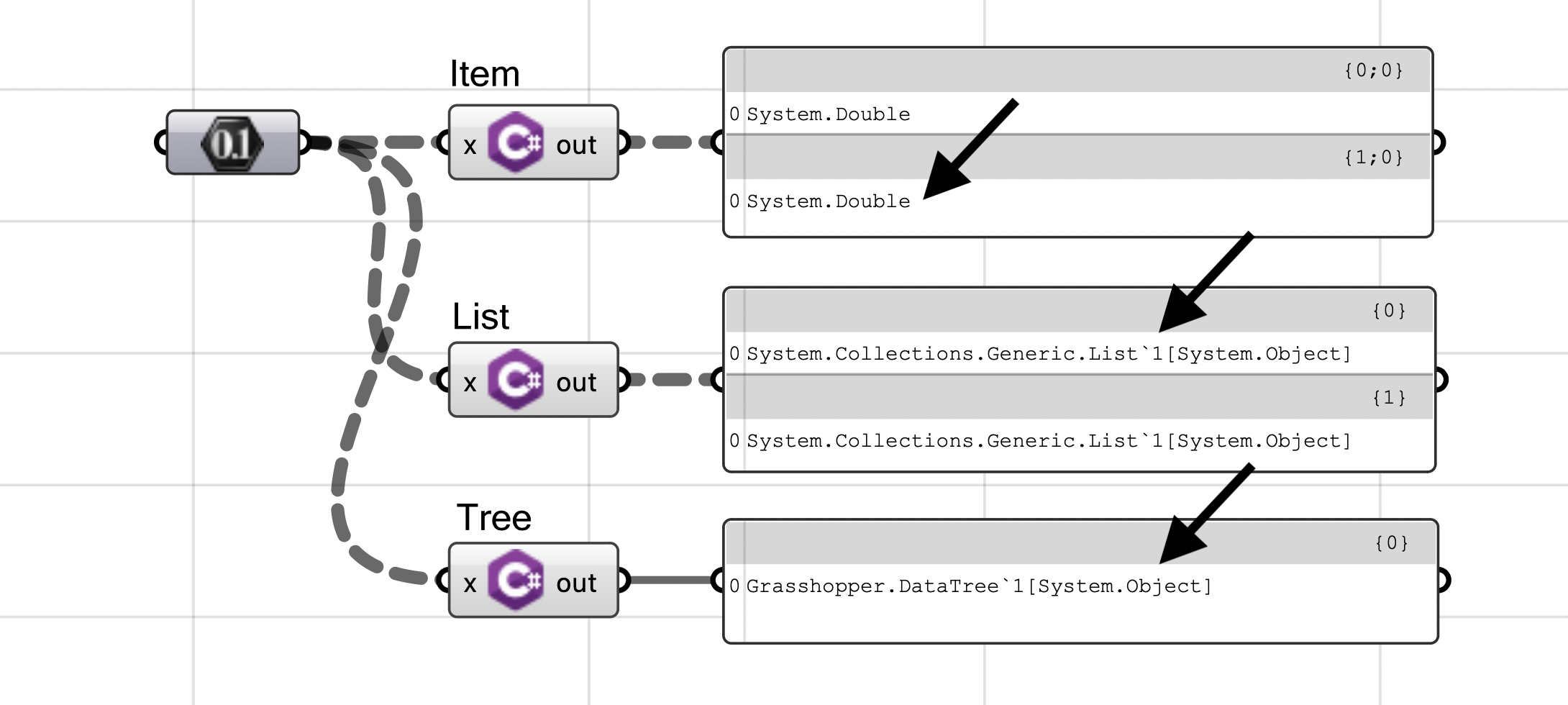
To get the generic collection data structures to use the correct double type, we can apply a double Type Hint to input parameter x:

Required Inputs
Script input parameters are always created as Optional. This means that your script runs whether wires are connected to the inputs or not. However, sometimes it is important to mark an input as Required (not Optional) to ensure there is a value available on that input before script runs. This is especially important if you are planning to publish your scripts.
As of Rhino 8.14, there is a Required option on the input context menu that you could check to make an input required:

Extracting Parameters
Grasshopper allows extracting an input parameter from a component. Parameters on a component are independent entities that could exist as inputs or outputs on a component or as floating parameters (Types of Parameters).
You can extract a script input by choosing Extract from the right-click menu on the parameter:
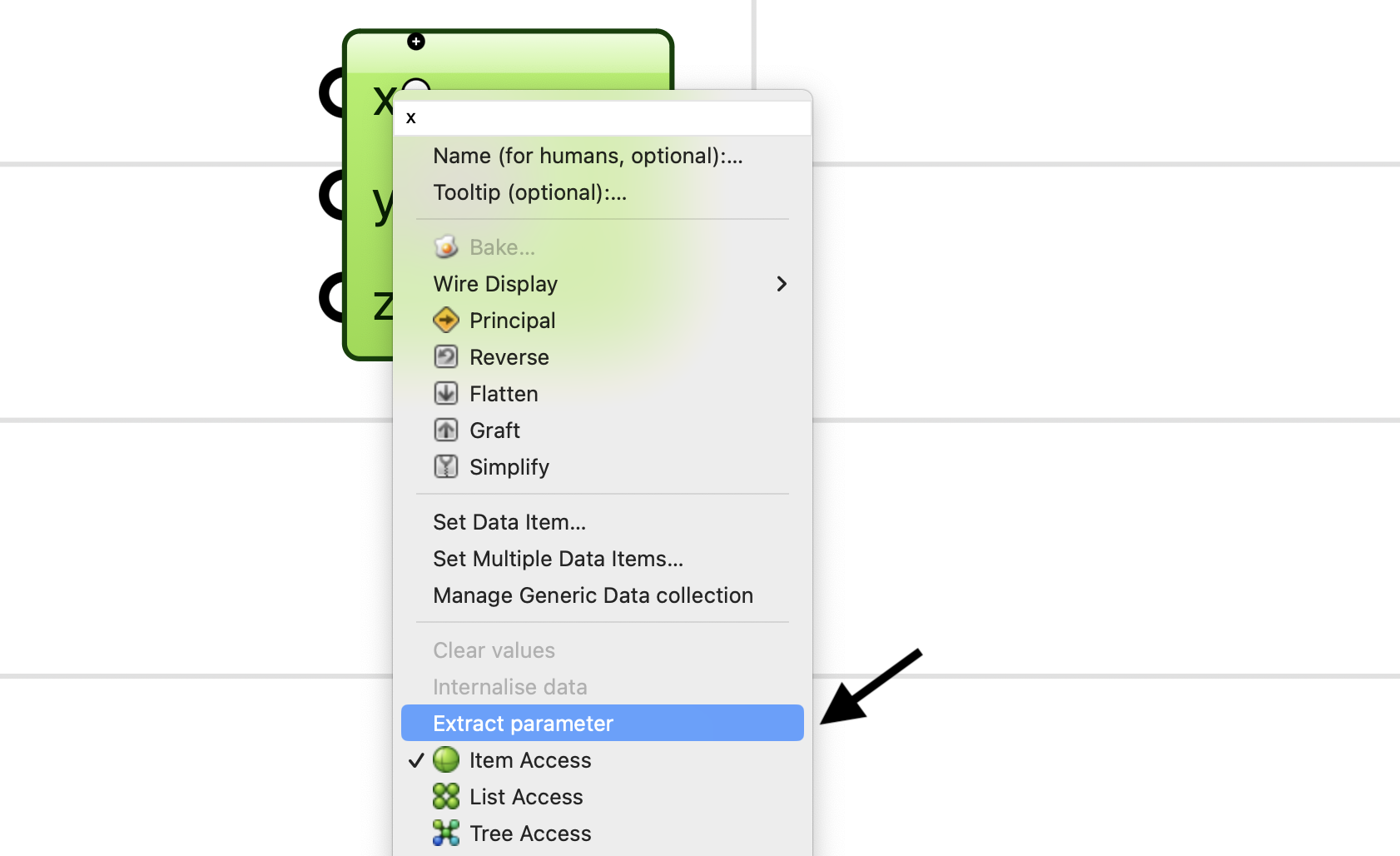
If you have a Type Hint set on a parameter, the extracted floating parameter will be of that data type:
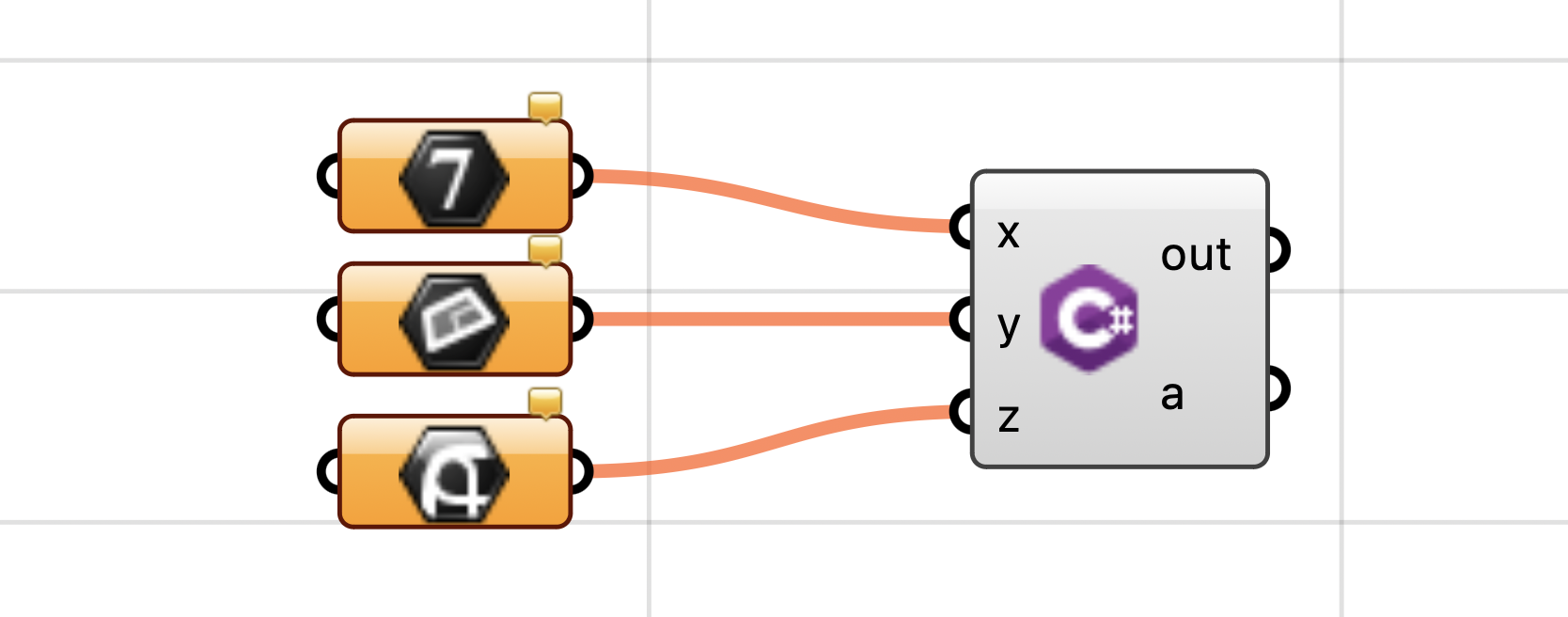
SDK-Mode
There are two ways you can create a C# script in Grasshopper. The first and the easiest is to write a C# script in the simplest form. For example, if we want to pass the sum of our two x and y inputs to the a output, we would create a script component with this script:
a = x + y;
Note that we did not add and using statements to our script because we are only using builtin C# functionality here that is addition of two numbers.
However, a typical Grasshopper component can:
- Execute code Before component is asked to solve the inputs (BeforeSolveInstance)
- Solve the inputs and pass results to outputs (SolveInstance)
- Execute code After component is finishing solving the inputs (AfterSolveInstance)
- Execute code to draw geometry wires on Rhino viewports (DrawViewportWires)
- Execute code to draw geometry meshes on Rhino viewports (DrawViewportMeshes)
The methods linked above are part of Grasshopper SDK for creating custom components. Every developer that creates a Grasshoper plugin is aware of these methods and might be using them to customize the component behaviour.
In a C# script component, we can implement our scripts in a similar manner. That is why we are calling it the SDK-Mode as it provides similar functionality that is available in Grasshopper SDK.
By default when you create a C# script component, the template script is already in SDK-Mode as this is how C# components before Rhino 8 have been working and we kept it the same in Rhino 8 and after.
This is how the default script looks like (actual script might not be identical):
using System;
using Rhino;
using Rhino.Geometry;
public class Script_Instance : GH_ScriptInstance
{
private void RunScript(object x, object y, ref object a)
{
// Write your logic here
a = null;
}
}
GH_ScriptInstance is the base class that implements methods below, similar to Grasshopper components:
BeforeRunScript: Execute code Before component is asked to solve the inputsRunScript: Solve the inputs and pass results to outputsAfterRunScript: Execute code After component is finishing solving the inputsDrawViewportWires: Execute code to draw geometry wires on Rhino viewportsDrawViewportMeshes: Execute code to draw geometry meshes on Rhino viewports
This class provides base implementation for these methods except for RunScript that we must implement. In the example above, we subclass from GH_ScriptInstance and provide an empty implementation for RunScript.
RunScript Signature
The RunScript method signature is going to include all the component inputs and outputs by their name and data type (based on their Type Hints). All outputs are passed by reference using ref keyword so that providing a value for them would be optional.
You can write the logic of your component inside the RunScript block, take the input values, compute, and set the outputs. As with any other Grasshopper component, the RunScript method might be call multiple times based on the pairing of input data.
Changing RunScript Signature
Script component is smart enough to update the RunScript signature when parameters on the component are changed. It is also capable of updating parameters on the component, when the RunScript signature is manually edited:
Notice that input and output types will be used to apply an appropriate Type Hint to the parameter. The collection type of the input (List, or DataTree) is also used to apply the correct access kind to the associated input parameter.
If the data type does not have an associated Type Hint, it will adopt a Cast Type Hint that tries to directly cast input values to the data type:
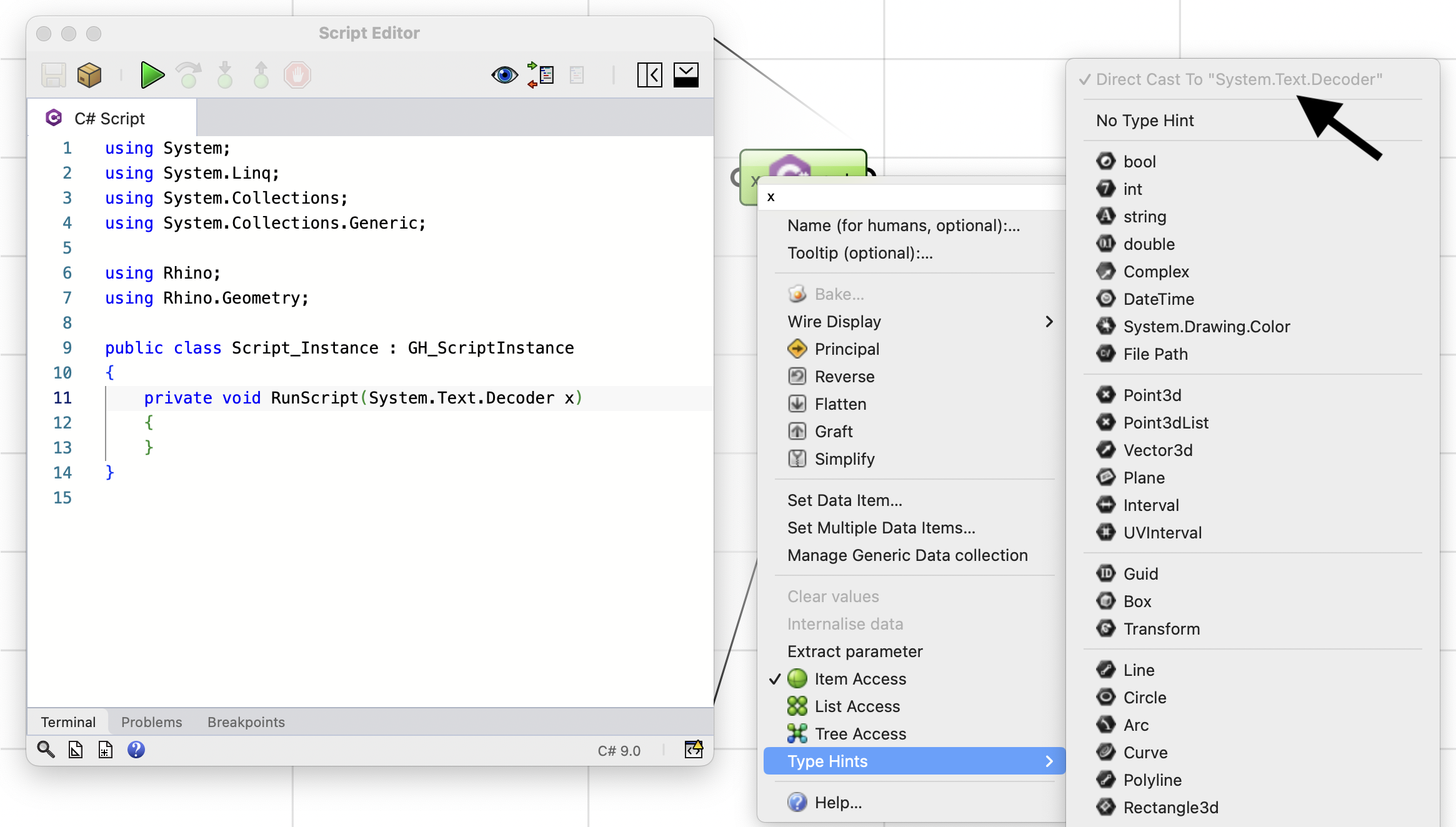
Before, After Solve Overrides
You can easily add the BeforeRunScript and AfterRunScript methods to your Script_Instance implementation by:
- Click on the Add SolveInstance Overrides button on the editor dashboard
- Click on the Add SolveInstance Overrides menu inside the Grasshopper menu on the editor
- Typing them yourself
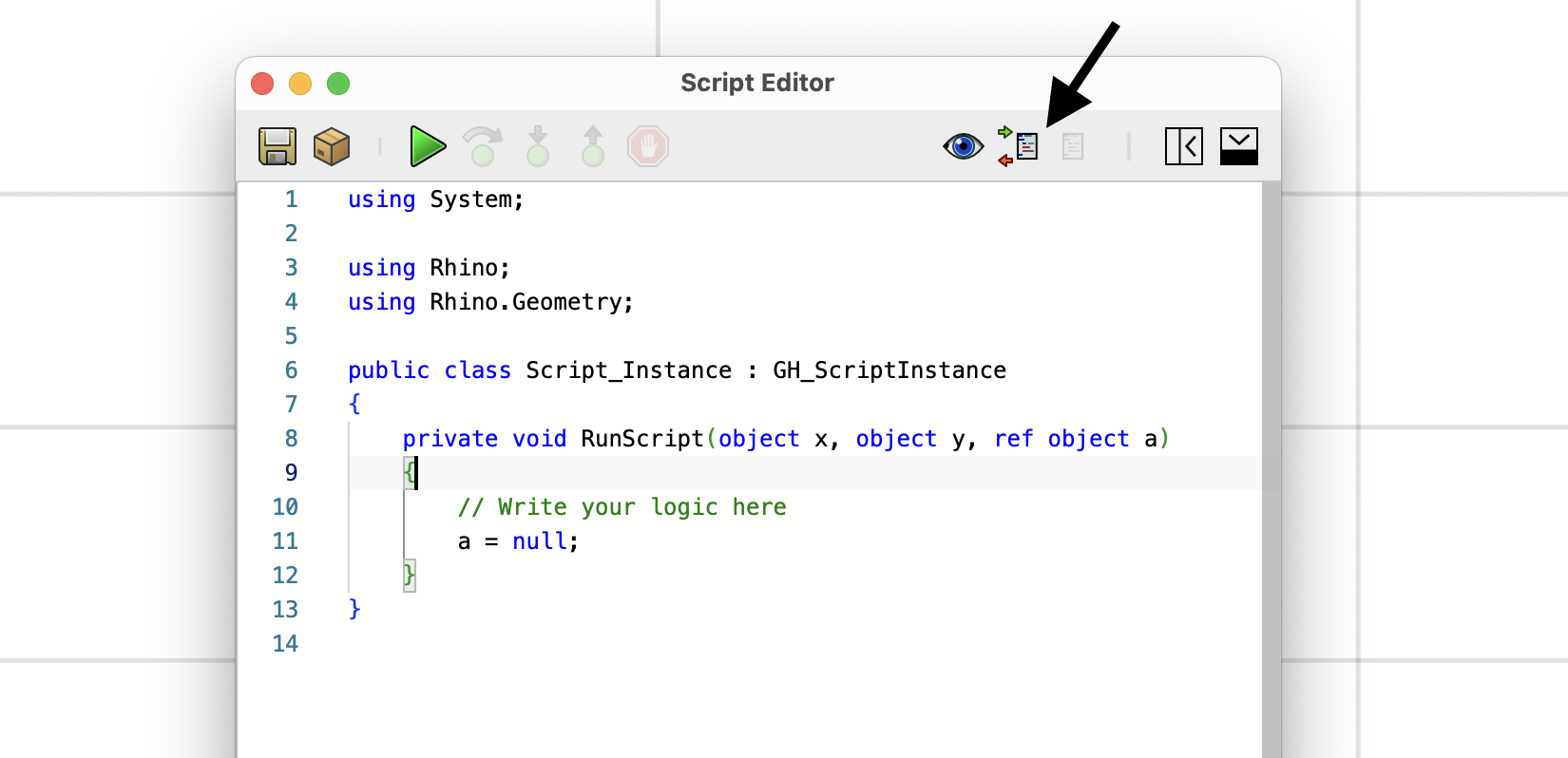
These two methods will be added to the class implementation:

BeforeRunScript and clean them up after the execution during AfterRunScript. The component is not allowed to make changes to the output parameters inside these methods.Each one of these methods is executed only once, per one full execution of this component. We can put a few print statements in these methods, and check the order of execution:

There are two range components included in this example to provide inputs to the script component. Each range component outputs 3 items, and their associated input parameter on the script component has a double Type Hint assigned to it. This means the RunScript method is going to be executed 3 times for 3 pairs of x and y.
Notice that the text Before Solve is printed on the same output item as Solve #0 which is the first iteration of solving inputs. This is because BeforeRunScript runs before the script component is allowed to set values on its output parameters and therefore any output printed to the console are going to be captured by the first iteration of RunScript that runs right after.
All other iterations of RunScript will continue after the first.
The AfterRunScript is executed after all the iterations of RunScript have completed execution. Notice that the text After Solve is captured and appended to the last message on the out parameter which belongs to the last iteration of RunScript that ran right before.
Preview Overrides
You can easily add the DrawViewportWires and DrawViewportMeshes methods to your Script_Instance implementation by:
- Click on the Add Preview Overrides button on the editor dashboard
- Click on the Add Preview Overrides menu inside the Grasshopper menu on the editor
- Typing them yourself
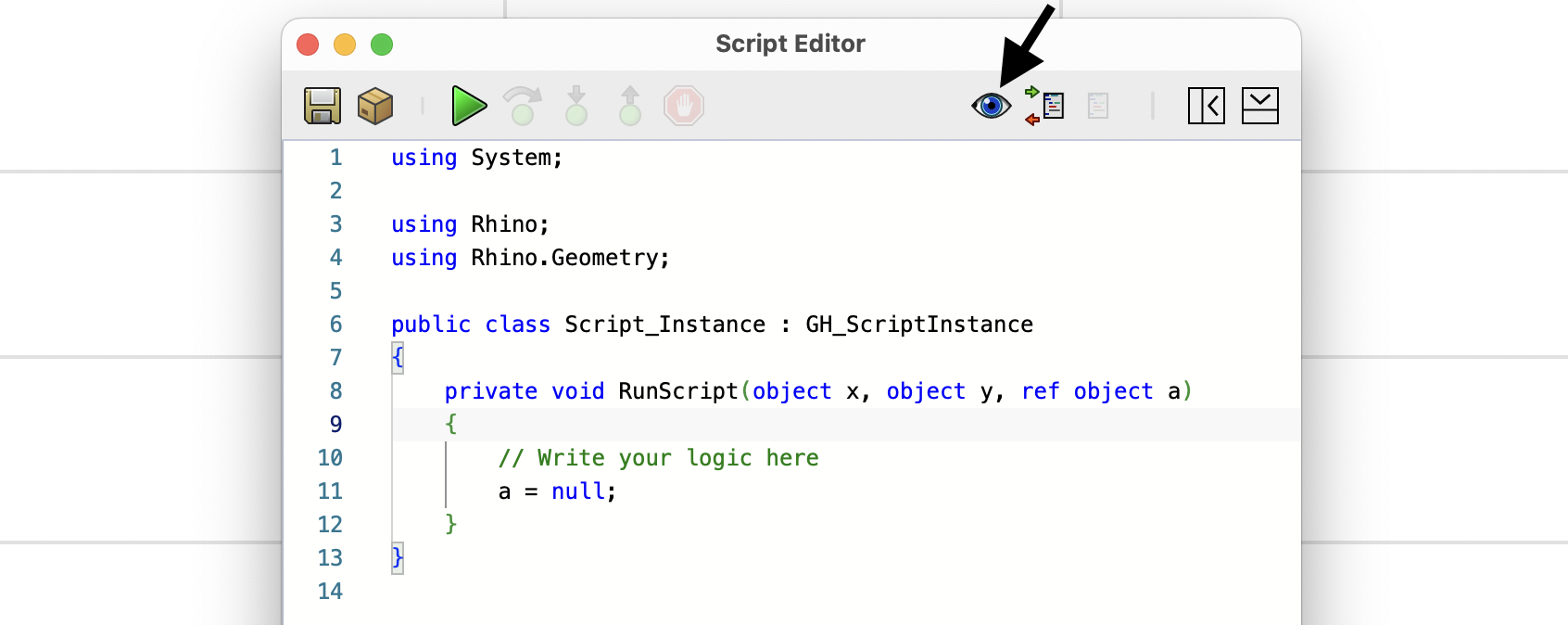
These two methods will be added to the class implementation:

DrawViewportWires is called first and here you can draw points and curves. DrawViewportMeshes is called later and this is where you can draw transparent shapes, such as meshes.
Notice there is also a ClippingBox property implementation that is added as well. The default value is BoundingBox.Empty but you should change that to a larger bounding box that bounds any custom geometry being drawn by your component.
Here is an example of a component that draws a 2D filled rectangle at the top-left corner of Rhino viewport:
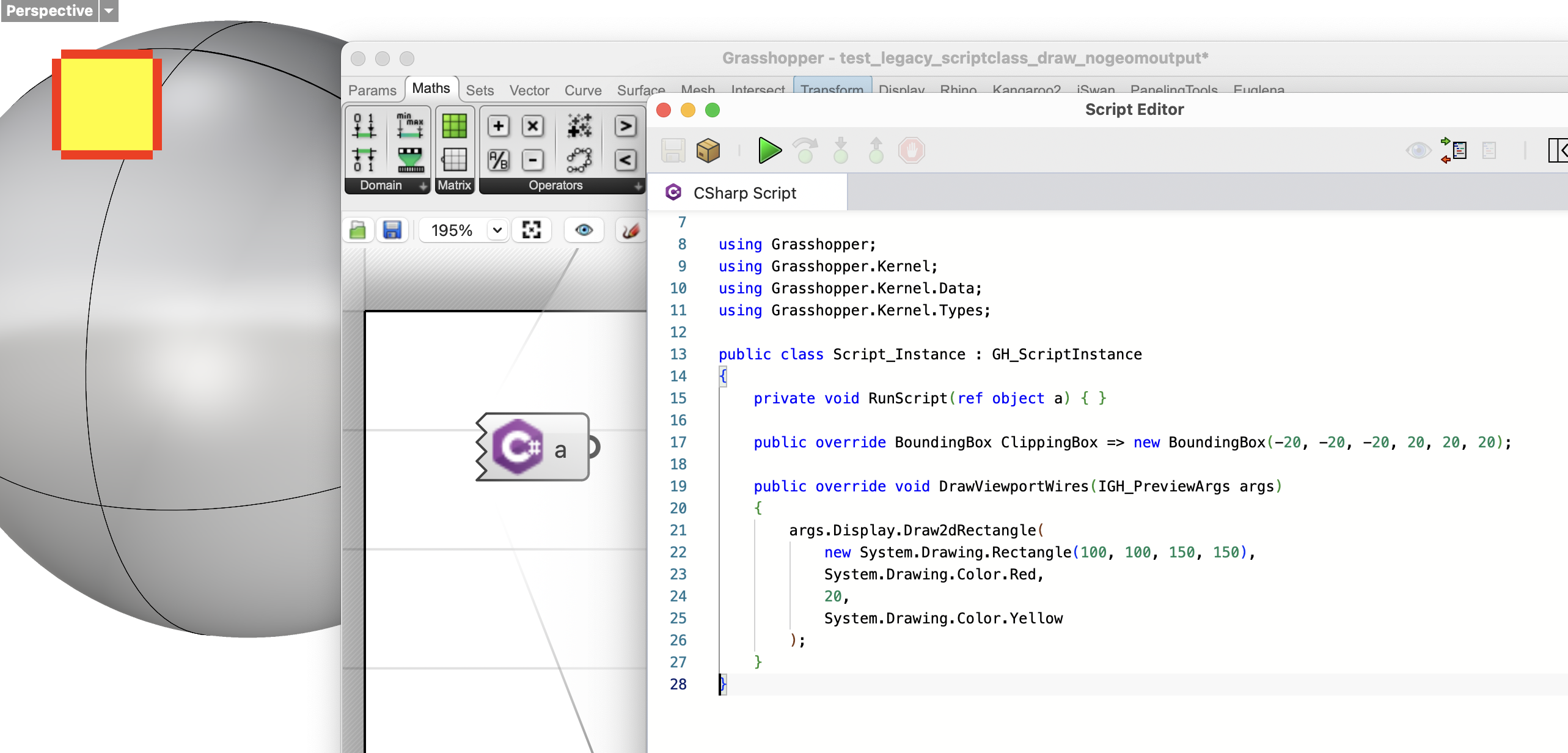
An argument of type IGH_PreviewArgs is passed to these preview override methods. As you can see in the example above, you can access the args.Display property which is a Rhino DisplayPipeline instance and has a lot of helpful draw methods.
System.Drawing framework for its graphical interface. They both have similar data structures (e.g. Rectangle) but it is important to know when working with Grasshopper preview overrides to use System.Drawing data types.Draw Calls
It is very important to know that Preview Overrides are fundamentally different from Solve Overrides (BeforeRunScript, RunScript, AfterRunScript) in a sense that they are executed outside of Grasshopper solution and are designed to work in tandem with the solve methods.
When you interact with a component, Grasshopper triggers a new solution on the definition. When solution is completed, Grasshopper is ready to draw previews on all the geometries generated by the components on the canvas.
Any interaction with Rhino viewports results in Grasshopper receiving a request from Rhino to draw its previews in the viewports. These draw requests happen anytime you interact with Rhino viewports and a Grasshopper definition is open.
This is exactly where the Preview Overrides come into play. Their main purpose is to peform custom drawings in Rhino viewports based on the results of the computation done by Solve Overrides. Contradictory to the solve methods, the Preview Overrides are continuously called as you are interacting with the Rhino viewports.
Script-Mode
A simpler, more script-like, method of using C# Script Component is to write C# code in the script editor without implementing the GH_ScriptInstance class. This method does not support running code before and after the script or creating custom graphics on Rhino viewports, but it is great for any script that does not need these functionalities.
Here is a very simple example:
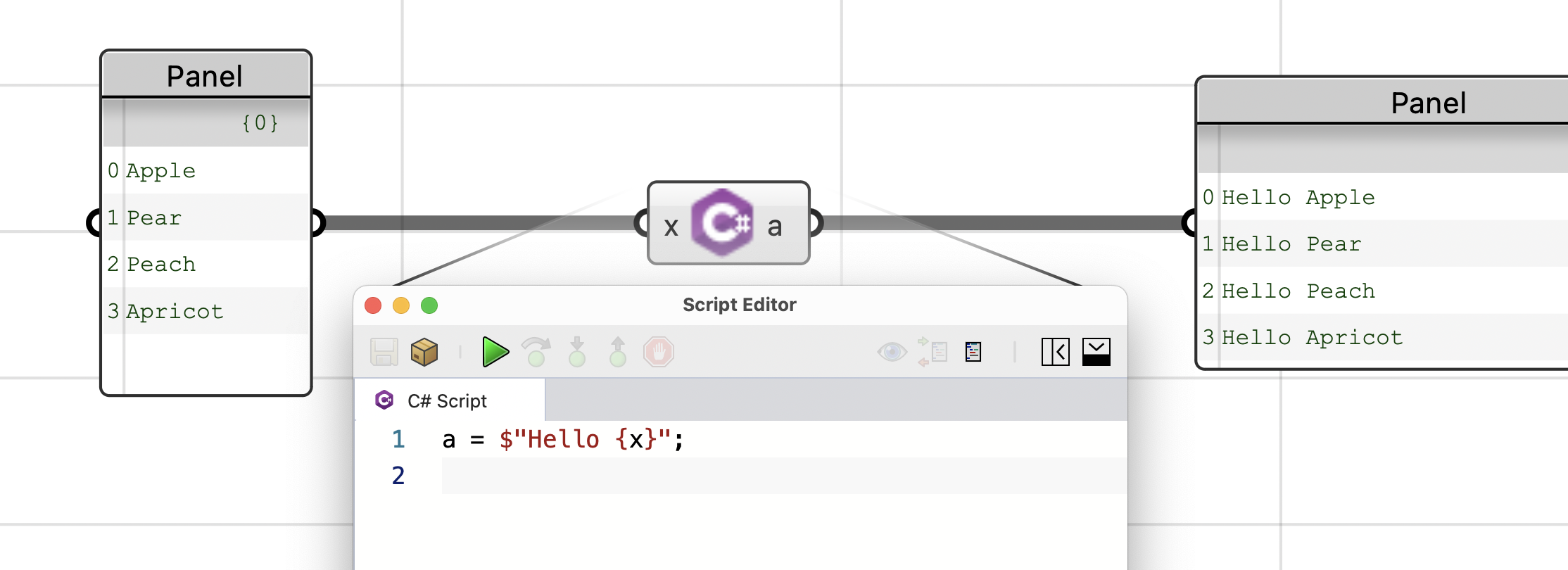
Check out NuGet Packages for another example.
Accessing Inputs
Notice that we do not have a RunScript method that would show the input and outputs and their data types. The x input parameter is magically defined and set before your script starts. You can reference the input values anywhere in the Global scope of your script.
In the example above, the output x is already defined and set in the script scope, and its value can be used in the script:
a = $"Hello {x}";
You can also define functions in the global scope without defining classes. These global functions can access the globally defined parameters:
using System;
double Solve()
{
return x + y;
}
a = Solve();
However, the script below will throw an error since Solver.Compute() method does not have access to the x and y inputs defined in the global scope. This is a limitation of C# language itself and is by design:
using System;
Solver s = new Solver();
a = s.Compute();
class Solver
{
public double Compute()
{
return x + y;
}
}
In these cases, try passing the desired values to your custom methods:
using System;
Solver s = new Solver();
a = s.Compute(x, y);
class Solver
{
public double Compute(double left, double right)
{
return left + right;
}
}
Settings Outputs
As mentioned above, in Script-Mode, the output variables are magically defined in the script scope by the component. Assign the desired values to the outputs in your script and they will be set on the component outputs.
Debugging Scripts
You can debug your C# scripts in the script editor. During debug, we can execute the script line by line or pause the execution at certain lines called Breakpoints and inspect the values of global and local variables.
Move your mouse cursor to the left side of any script line and click to add a Breakpoint:
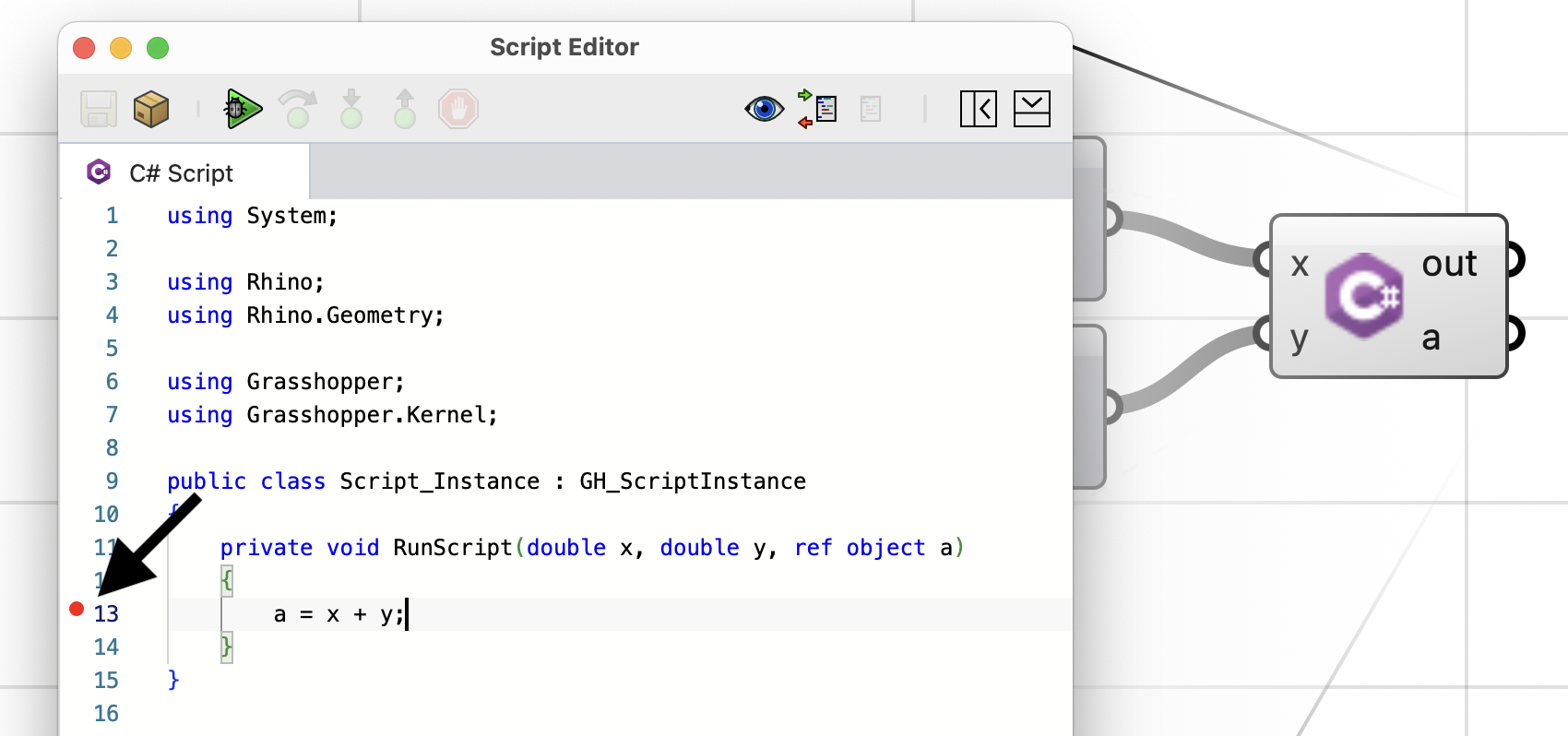
The Breakpoints tray at the bottom will show all the breakpoints, and will provide buttons to Enabled/Disable or Clear them:
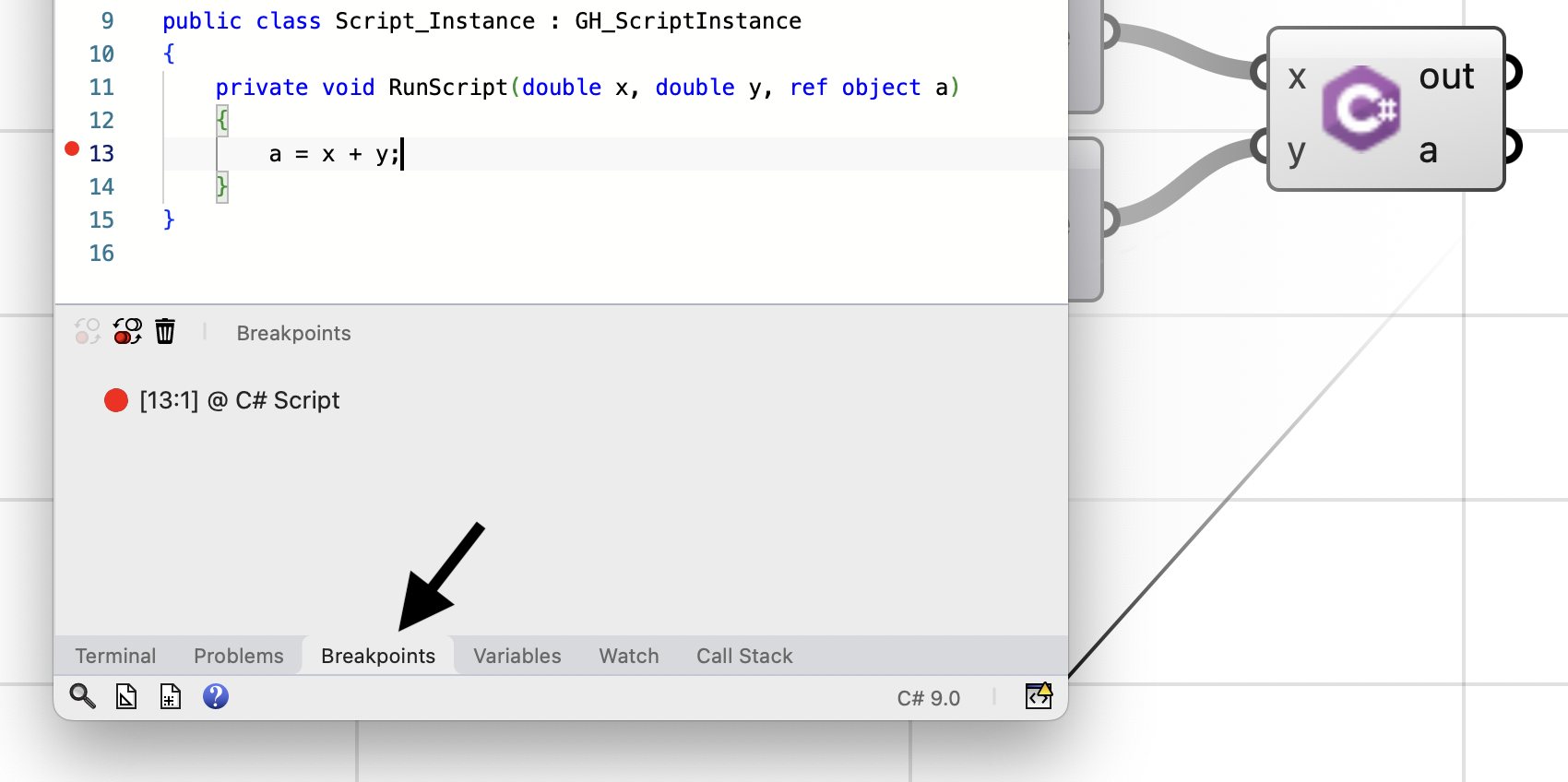
Use the Toggle button to activate or deactivate the breakpoints. Deactivated breakpoints will show up as gray dots in the editor:
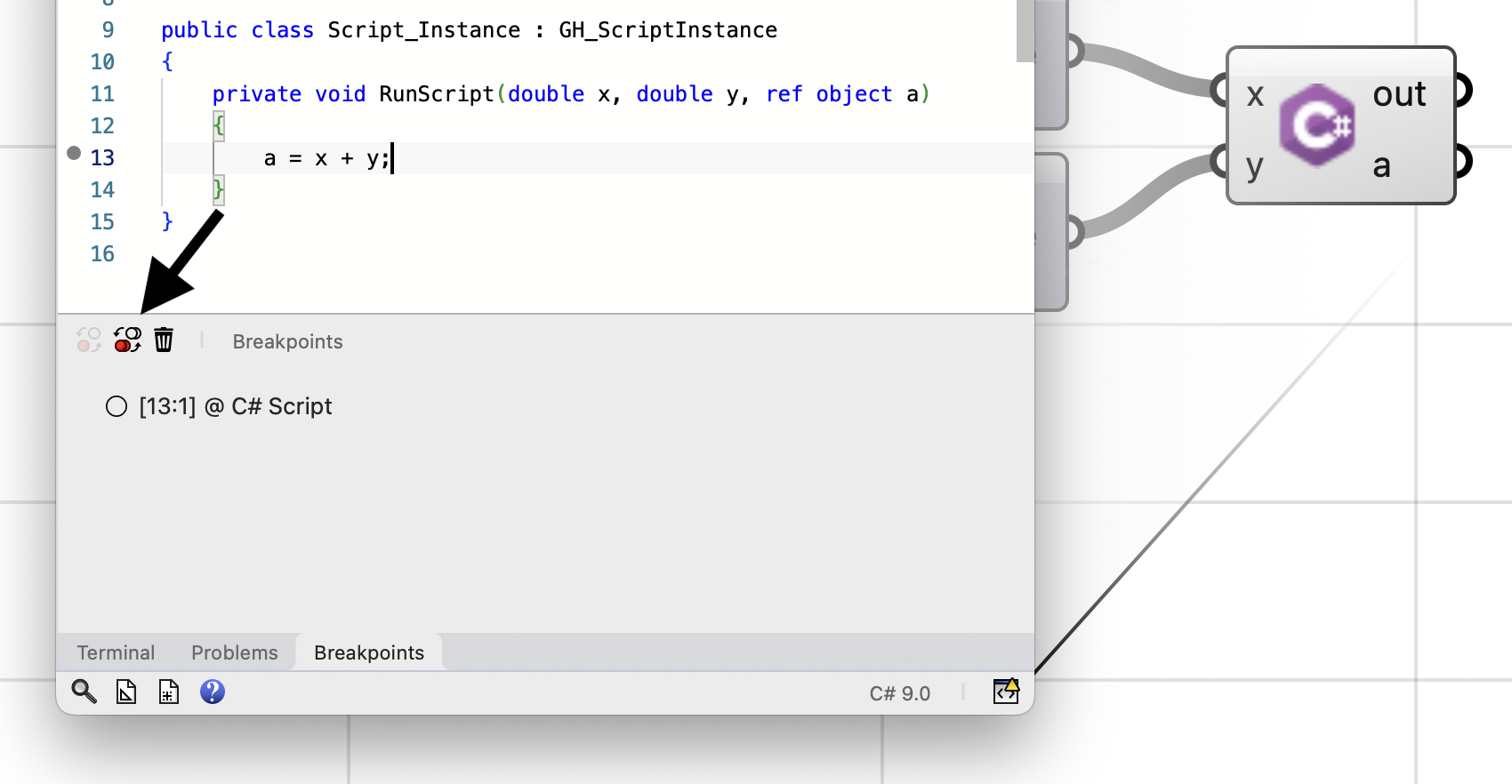
When you add breakpoints, the editor makes a few UI changes and provides a few more utilities for debugging:
- The Run button will change to Debug
- Variables, Watch, and Call Stack trays will be added to the bottom tray bar
Now click on the green Debug button on the editor dashboard. The editor will run the script and:
- Stops at breakpoints
- Highlights the breakpoint line in orange and shows an arrow on the left side of the line
- Highlights status bar in orange to show we are debugging a script
- Activates the debug control buttons on the editor dashboard
- Opens the Variables tray at the bottom to show global and local variables

We can control the execution of script using the debug control buttons on the editor dashboard:
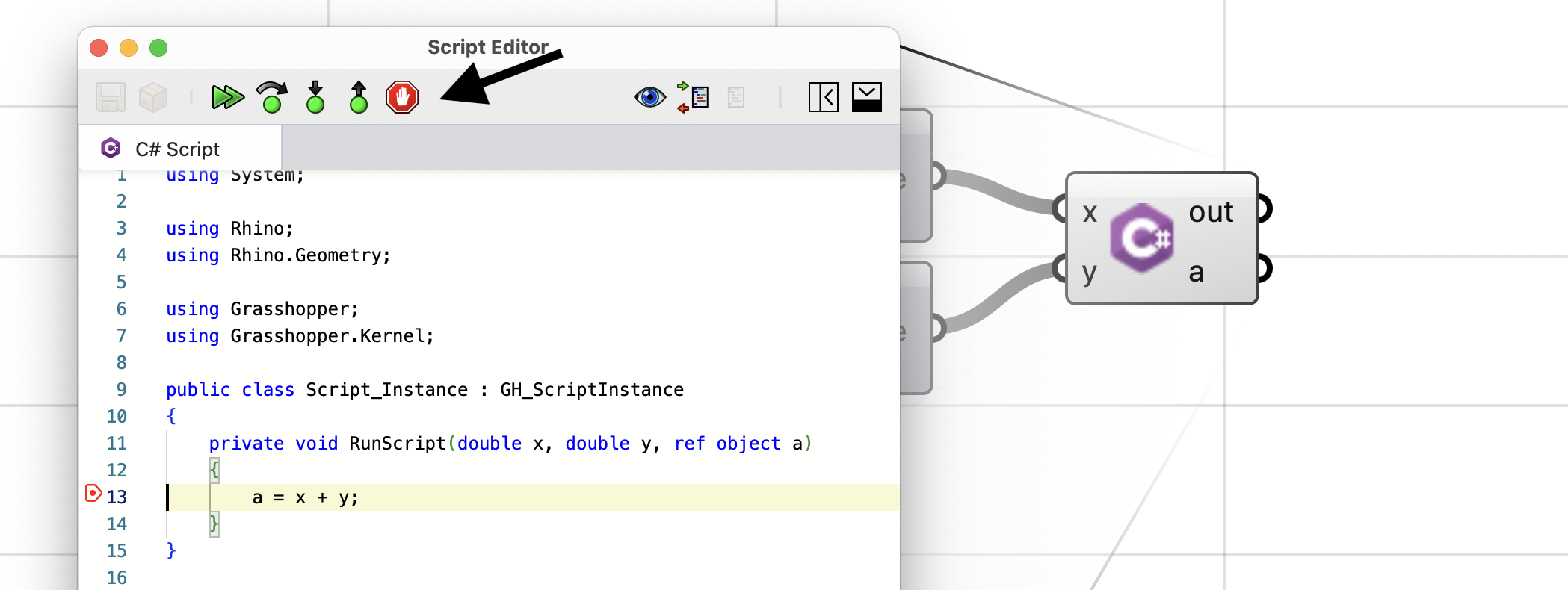
From left to right, they are:
- Continue: continues running the script until it stops on another breakpoint
- Step Over: executes current line and moves on the next line
- Step In: if the current line includes a function call, this will step into the lines defining the function code
- Step Out: if previously stepped into a function code, this will continue executing the function code until control is returned from the function to the calling code and will stop there
- Stop: stops debugging the script and does not continue executing the rest
Click on Continue to see the execution move to the next line:
Notice that the Variables panel now shows new values for x and y. The panel header also shows Run Script (2 of 11) on the top-right meaning this is the second time Grasshopper is executing this component with a pair of x and y inputs:
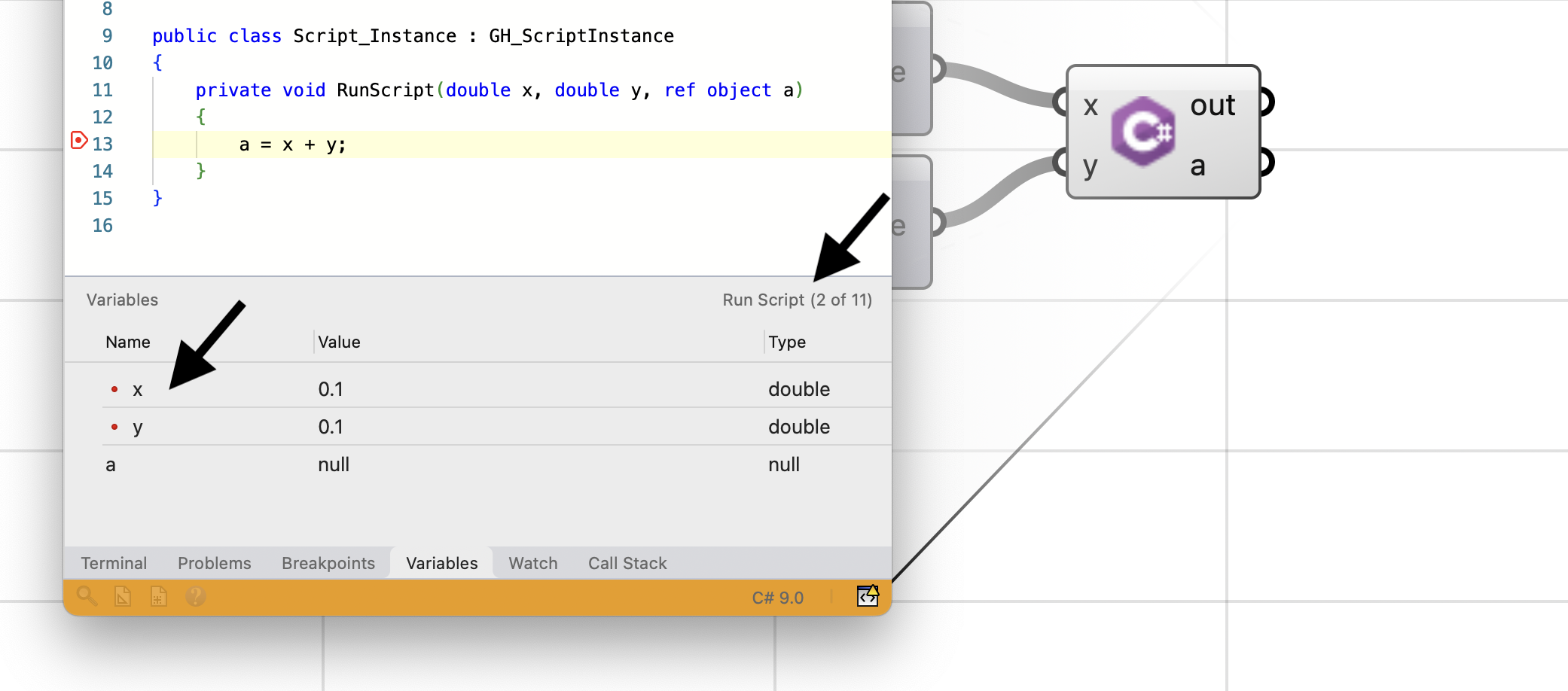
Progressively clicking on Continue will continue executing the script and modifying the variables. At each stop, the Variables tray shows the current values of global and local variables.
At any point during debug, the Stop button stops debugging. The script component will show an error marking with the message Debug Stopped:

Once the debug stops, the editor UI changes back to normal, and the Variables tray will show the last state of the variables. The tray will keep these data until another session of debugging is started.
Variables Tray
Variables tray is a great tool to inspect the current values of all the global and local variables in our script. Variables data is shown in a table with 3 columns: Name, Value, Type. For each variable you can see the current value and the type of data it is holding. A red marker will highlight the variables that changed during debug:

For more complicated data types with fields and properties, you can expand the variable to see current values of its members:
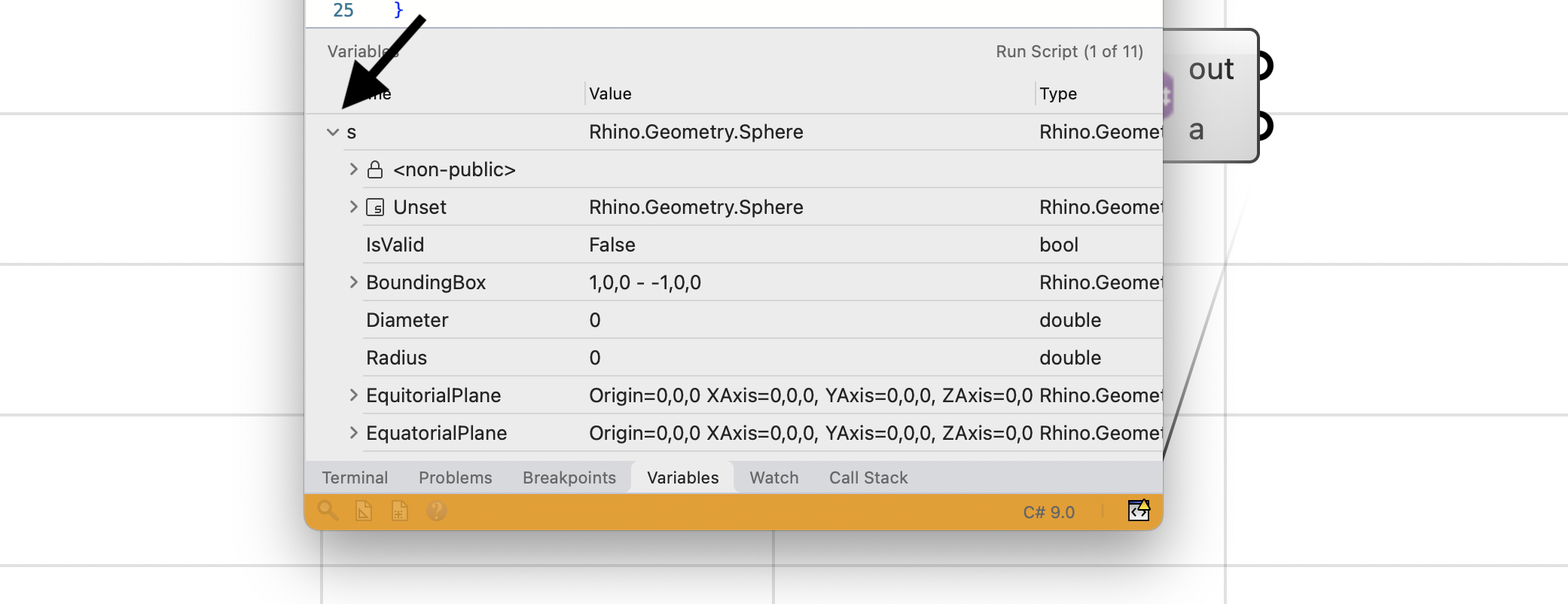
If a value is a collection of other values, you can expand the variable to see each item individually. The Name column shows the item index like [0]:
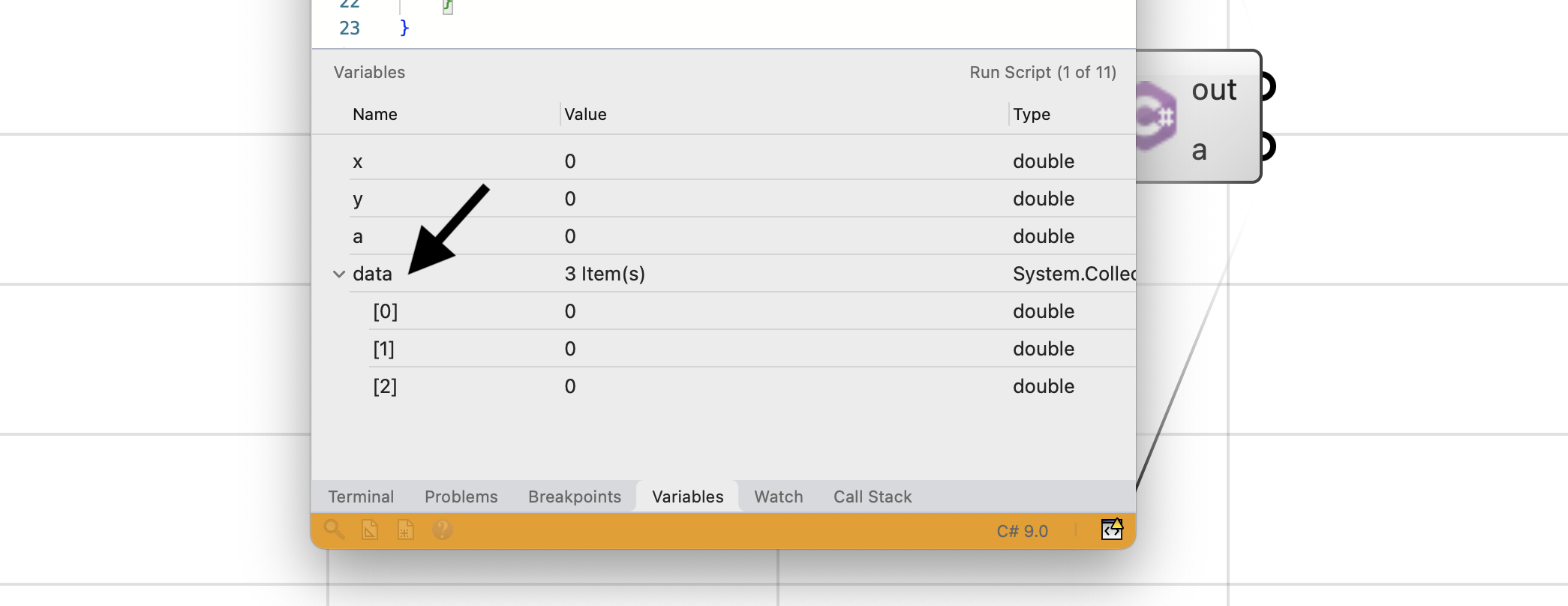
Watch Tray
Watch tray is very similar to the variables tray. The primary difference is that Watch tray only shows the variables that you have specifically added to watch. Use the Add Expression button on the tray toolbar to add a new variable to watch. Hit Enter on the added Expression item to edit and type the variable name:

Watch tray will show a green checkmark when it can extract the variable value during debug. A yellow warning icon is shown when the variable is not in scope:
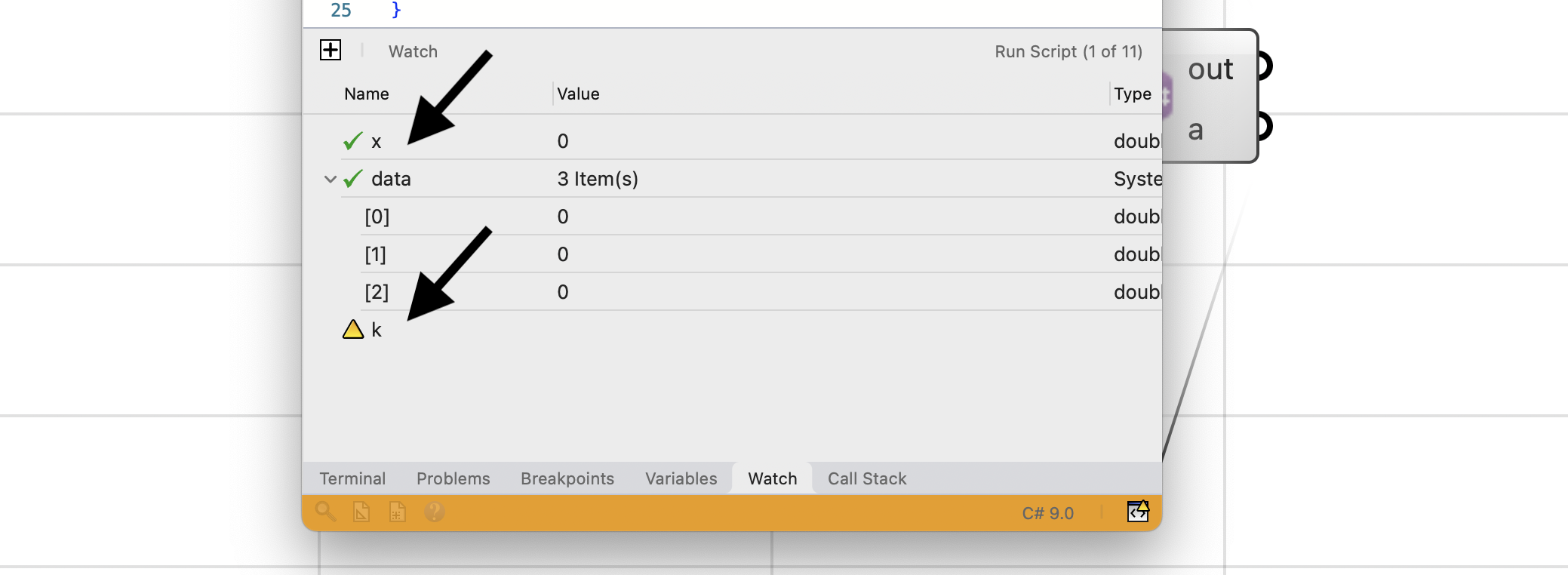
Call Stack Tray
Call Stack tray shows the call stack frames. This loosly translates to functions calls in our script. The item at the top is the last function that the script is executing, and the list goes on to show other functions that called the current function
In the example below, script execution started by running RunScript. Then the script called the Sum method and that is where we are paused during debug right now. Call Stack tray shows this function at the top of the list, with RunScript following right after. Variable and Watch trays also show the values of variables in the current call frame:

You can click on other stack frames, and switch to Variables or Watch tray to inspect the values in their scope:
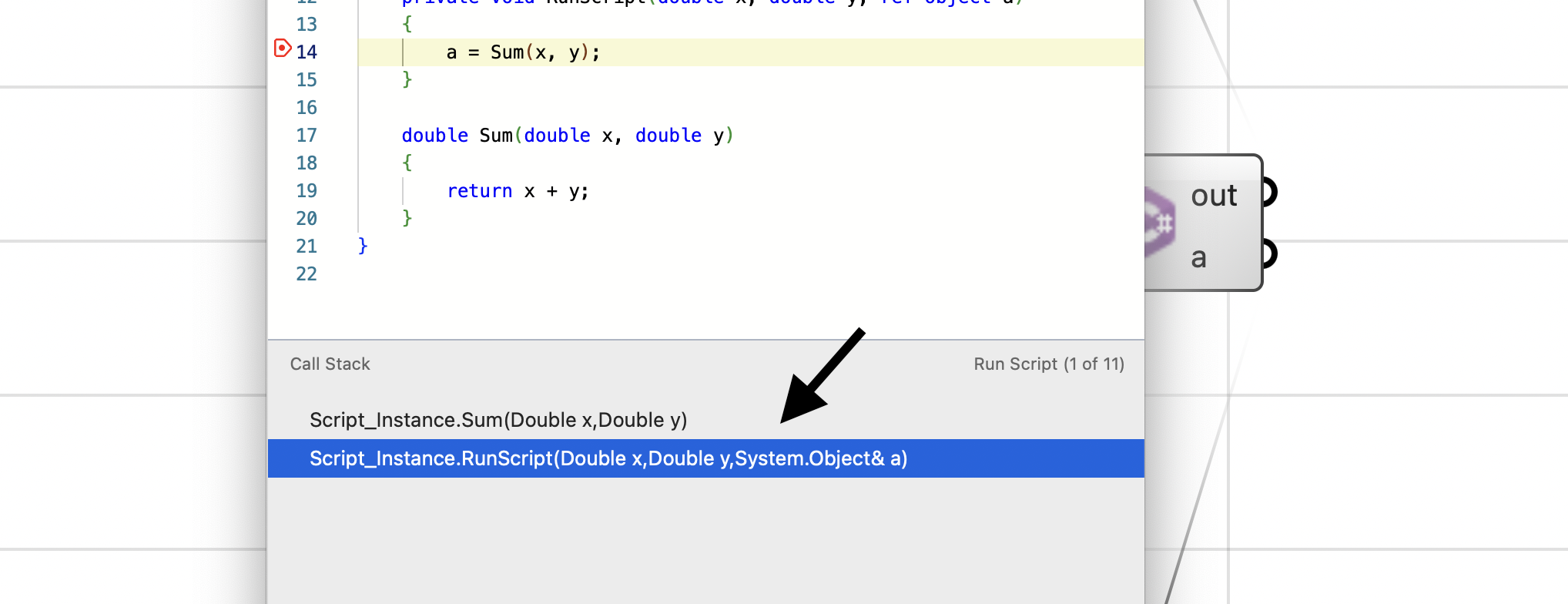
Call Stack tray shows stack frames for different threads in your script independently.
NuGet Packages
C# script can benefit from third-party packages that are published on NuGet package server. You can use the Install Package button to install any of these packages and use in your script:
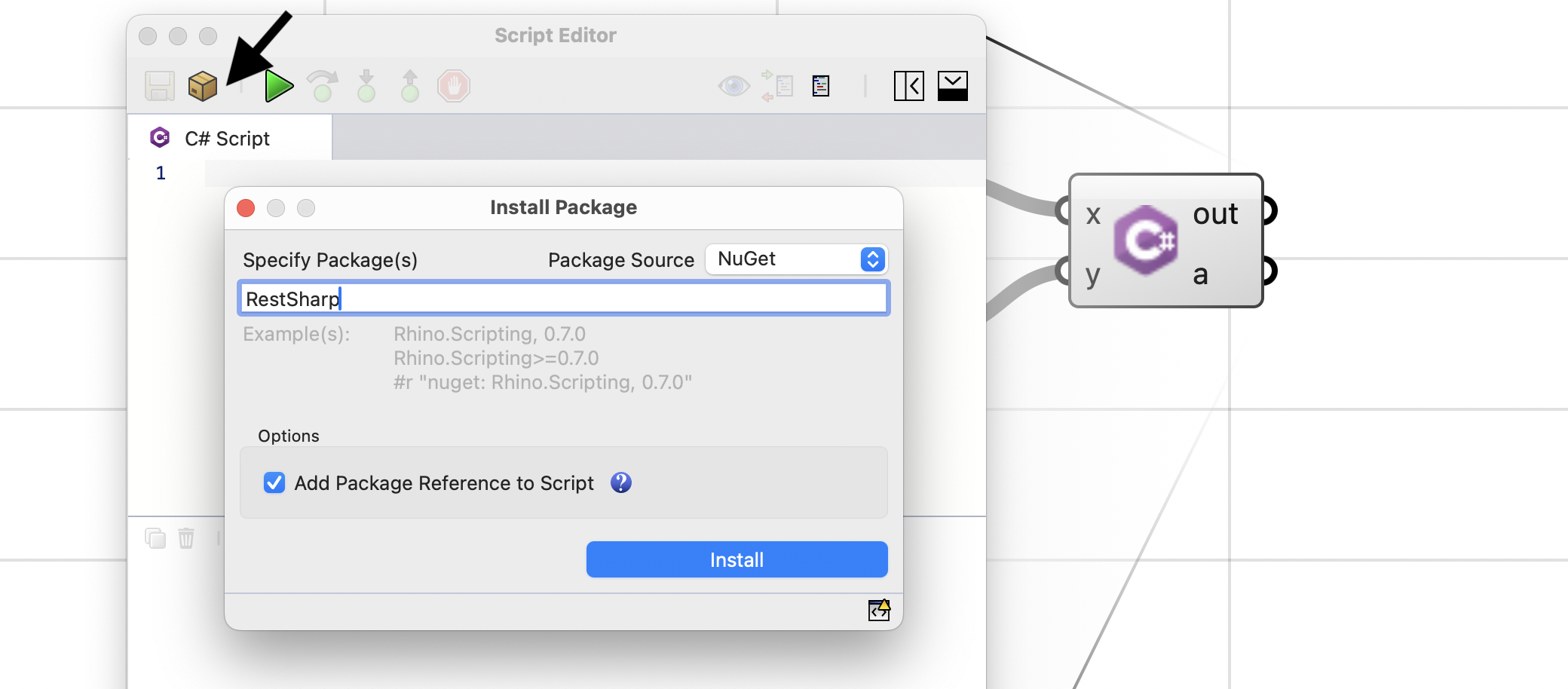
The Install Package dialog, shows a couple of example of how you can specify the package name and version requirements.
The Add Package Reference to Script option, when check (default), adds a package reference to the script text. In this manner, the script always knows which packages it needs even when you send this script to others and they do not have the required packages installed.
Notice the #r "nuget: RestSharp, 110.2.0" line in the example script below. The format follows the package reference for script on NuGet website:

#r "nuget: RestSharp, 110.2.0"
using System;
using System.Collections.Generic;
using Rhino;
using RestSharp;
using RestSharp.Authenticators;
var client = new RestClient("https://httpbin.org");
var request = new RestRequest("get");
var response = client.Get(request);
a = response.Content;
Assembly References
C# scripts can also directly reference dotnet assembly files. You can use the Install Package dialog and change the Package Source option to DLL Reference:
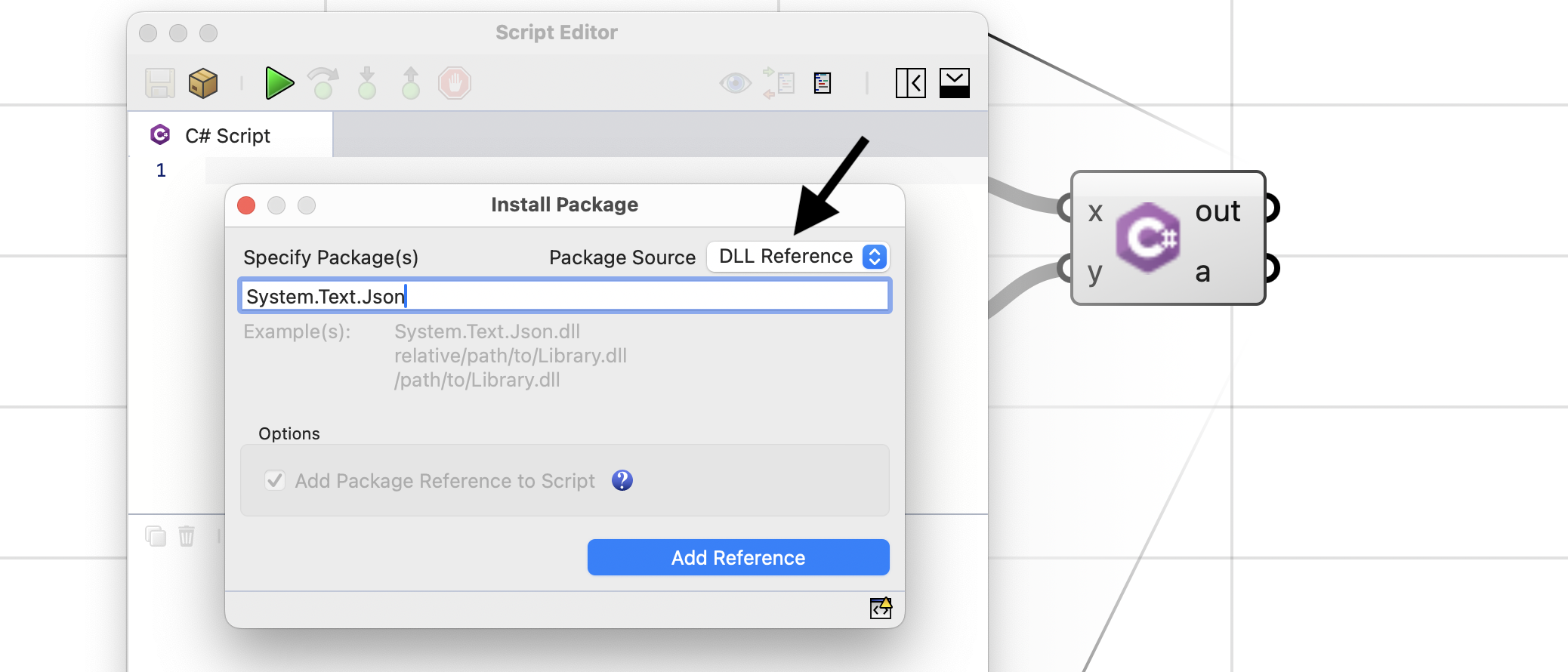
If the assembly is already loaded in Rhino, you can reference it by just typing the name of the assembly. Make sure the extension is included in the assembly name (e.g. .dll) A package reference like example below is optionally added to your script:
#r "System.Text.Json.dll"
As the Install Package dialog examples show, you can also provide a relative or absolute path to the assembly:
#r "/path/to/my/assemblies/MySharedAssembly.dll"
Customizing Editor
Script editor used in C# script component, is an embedded variant of the main script editor in Rhino that is launched from ScriptEditor command. The component script editor, has a Grasshopper menu and few other Grasshopper-specific buttons.
We have already discussed the SDK-Mode related buttons in the editor dashboard. Here is a description of other editor options that are useful in Grasshopper:
Close On Save
By default, when Saving the script in C# script component, the editor stays open. It saves the script and triggers a solution on the Grasshopper definition with the newly updated script.
This behaviour can be changed using the Grasshopper -> Toggle Close Editor On Save menu. When enabled, choosing File -> Save or Ctrl + S will save the script and close the editor (This is the default behaviour of the legacy script editor in GHPython component).
Layout Options
Script editor used in C# script component, has a series of toggle menus to change the layout of the editor and make it more compact. These options can be accessed from Window menu in the editor, and can be used to dedicated more screen space to scripting area, and also visually differentiate the Grasshopper editor from the main editor in Rhino.
They are also accessible from the Tools -> Options menu in the editor. Hover the mouse over the question mark icons to see more information on each option:

Toggle Dashboard
You can completely hide the editor dashboard and open up more space for script:

Toggle Compact Dashboard
When Dashboard is visible, you can save some space by making it more compact:

Toggle Compact Script Tabs
By default, Grasshopper editor does not show the script tabs, unless debug steps into a source file other than the main script. Toggle this option if you want the tabs to be always visible:

Toggle Compact Browser
By default Browser tabs are NOT shown on the left side of the editor in Grasshopper. The tab selector buttons are shown on the status bar to save some space. Toggle this option if you want to see the browser tabs on the left side:

Toggle Compact Console
By default Console tabs are shown on the bottom edge of the editor in Grasshopper. Toggle this option if you want to see the tab selector buttons on the status bar to save some space:

Publishing Scripts
If you are planning to publish your script components in a Grasshopper plugin, a few considerations are important.
Right-Click on the script component and set appropriate values for Tooltip. This description is used for publishing the script and is shown on the published component.

Right-Click on all input and output parameters and set a Name (Human-readable) and Tooltip for each parameter. The human-readable name is shown when Display -> Draw Full Names are enabled in Grasshopper. Setting a human-readable name and description helps understanding what inputs the component requires, and what outputs it provides and generally makes it easier to work with your published components.

Check out Creating Rhino and Grasshopper Plugins on how to publish your script components in a Grasshopper plugin.
Template Scripts
There are a few template scripts available in the Templates panel in the editor. You can Double-Click on any of these templates to replace the contents of your script with the template. This is a good way to start slightly more complicated scripts:
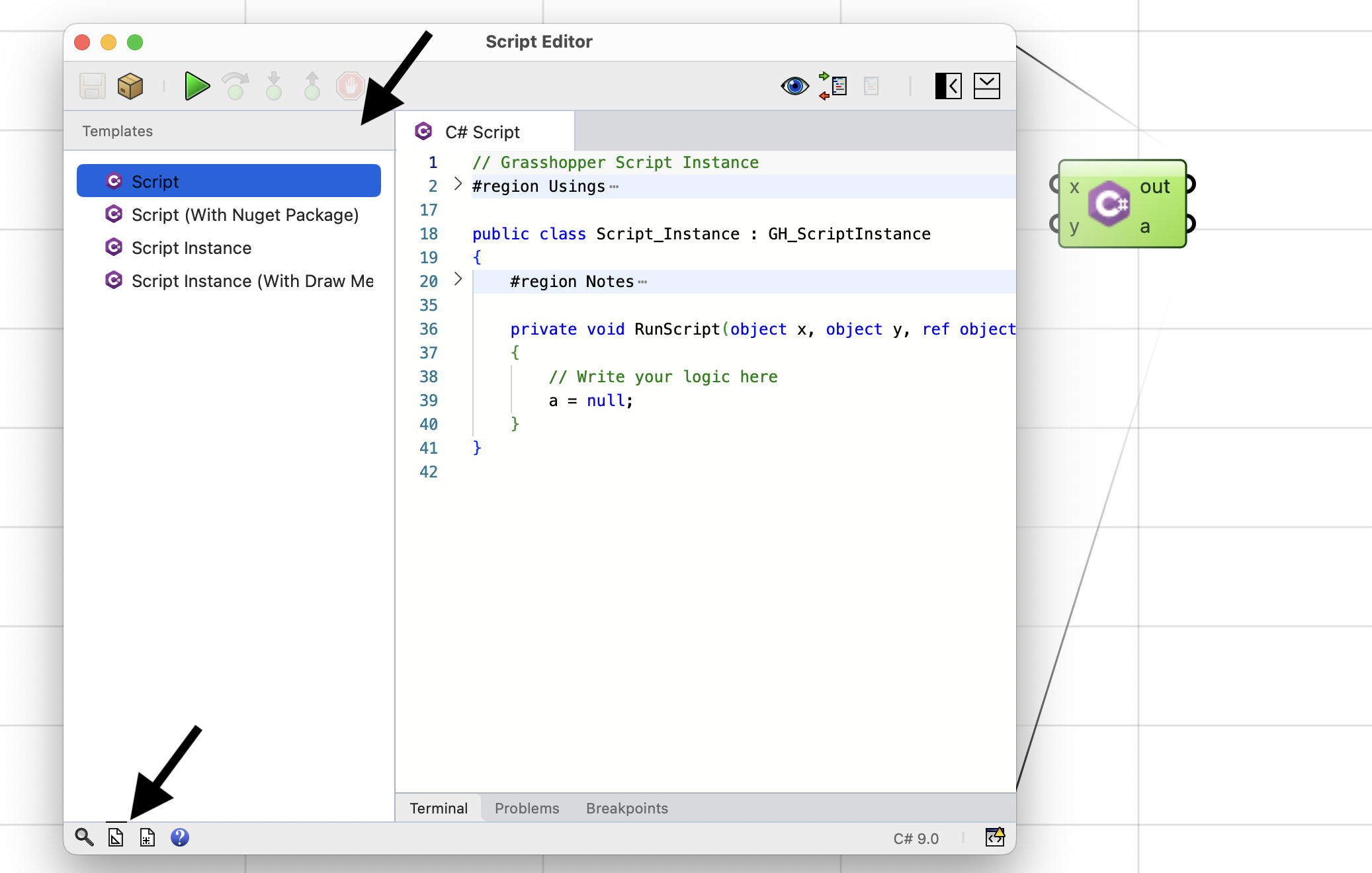
User Objects As Templates
Another great way to create template scripts is to setup one script component with the desired inputs, outputs, and template script, and then save that as a Grasshopper User Object. You can set extra metadata on the component and customize its icon. Every time you would place an instance of this User Object, you are effectively creating a new script component instance with the template script and parameters.
Resetting Icon
If you have a script component that has an overriden, incorrect, or low-resolution icon, you can reset the icon back to the default for the scripting language using the Reset Icon menu button in the Advanced context menu (Shift + Right-Click).
Shared Scripts
C# Script Component is most commonly used with a C# script that is embedded inside the component. However you can share a single script between multiple Script components.
Input Script
You can create a C# script (SDK-Mode is not yet supported for shared scripts) in a Grasshopper panel, and pass that as an input to multiple Script components. Script components have a special script input parameter that can be activated from the advanced context menu. Shift + Right-Click on the component and choose Script Input Parameter (“script”) to toggle this input:

Language Specifier Directive
Notice that the scripts starts with // #! csharp. This is called a language specifier directive. Its purpose is to embed the expected language in the script code itself as a comment and a known pattern. Since scripts that are stored in this way do not have a file extension the language specifier is necessary for the script component to determine the language it should use to run the script. Alternatively you can Right-Click on the script parameter and choose a language from the menu, but that means all the input scripts must be of the chosen language.
Also note that the component icon changes to a generic script icon. The reason is that a script component with an script input can executed any of the supported languages. Notice the language specifer for the second script is #! python 3:
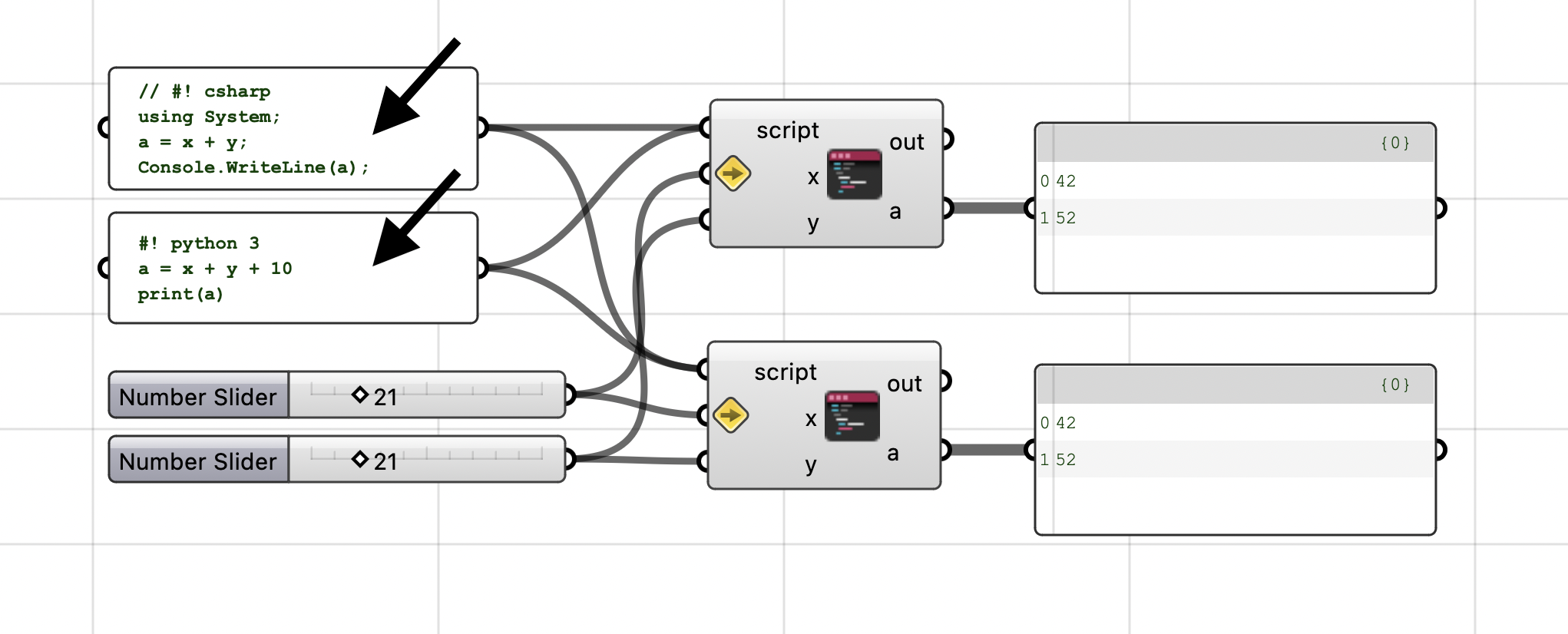
Output Script
Editing a script in a Grasshopper panel is not very convenient. Script components have a special script output parameter that can be activated from the advanced context menu. Shift + Right-Click on the component and choose Script Output Parameter (“script”) to toggle this output:
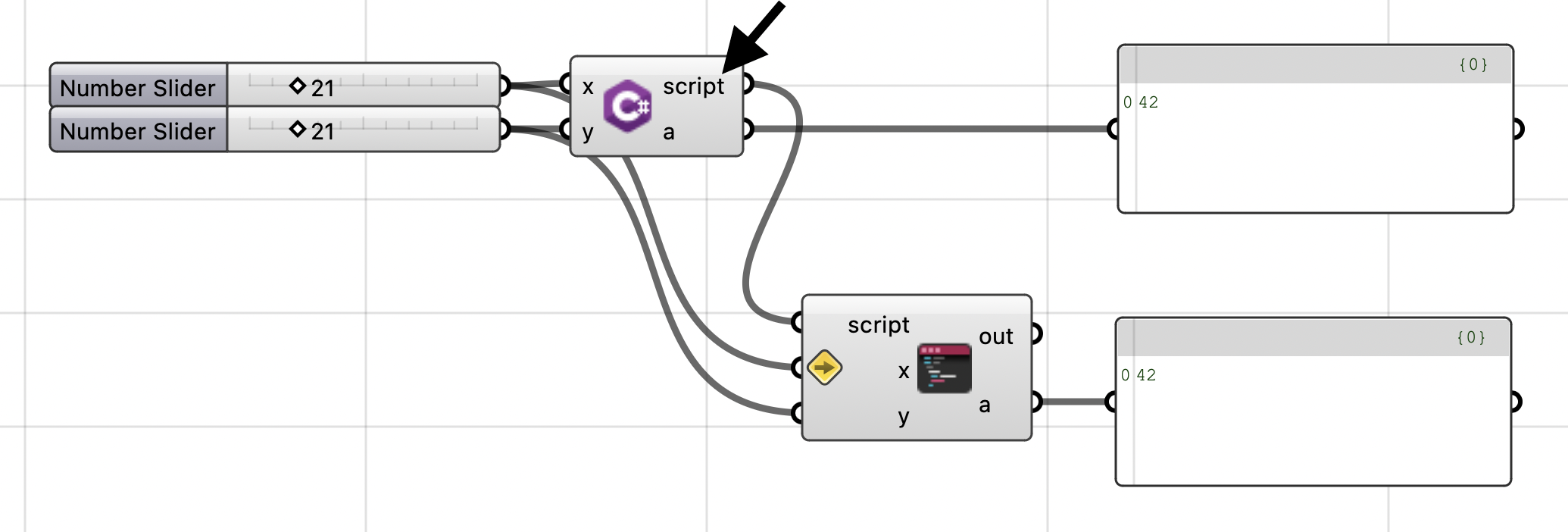
In this manner, we can use the first component to create and use our script, and pass the same script to other components to ensure they all run the same script. And as shown above, you can pass scripts of other languages to the script input as well:
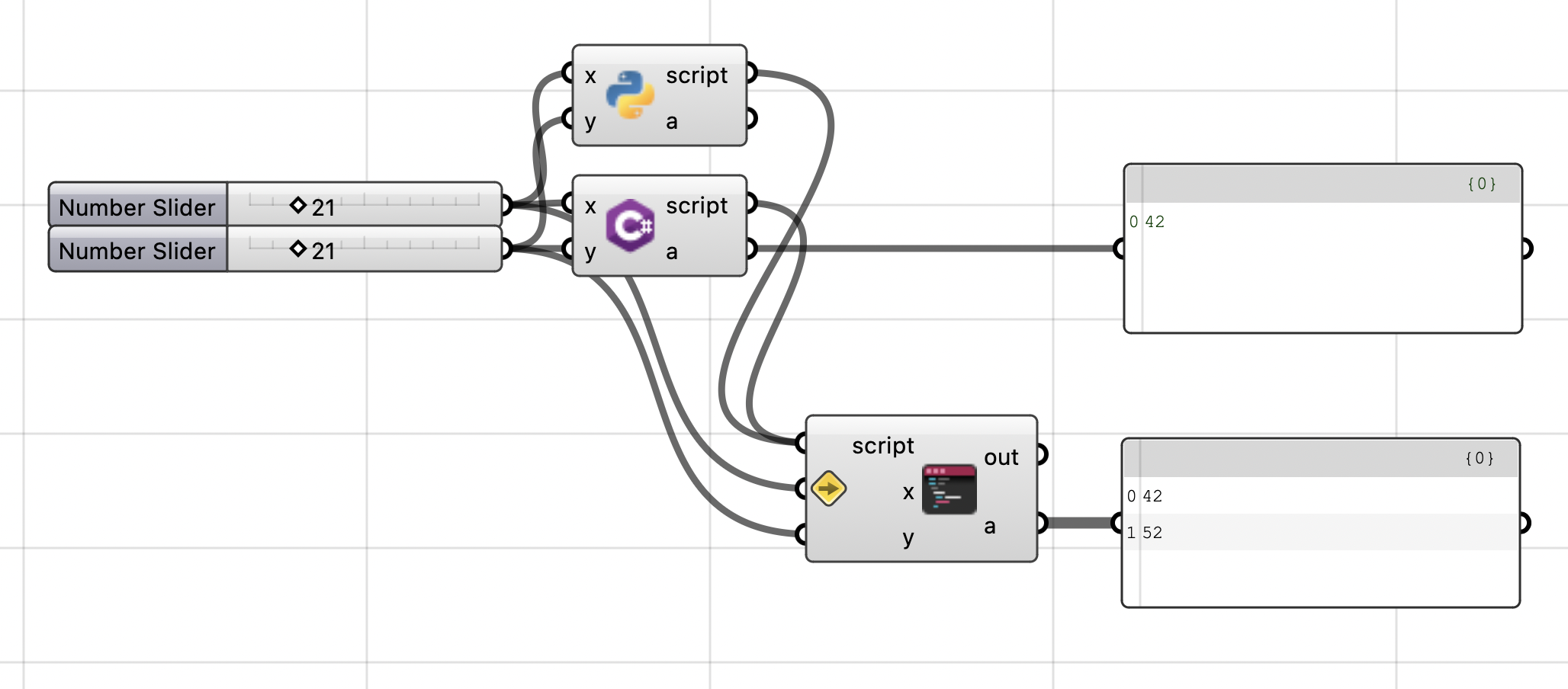
Value-Type Outputs
C# is a type-safe language and differentiates between Reference Types and Value Types.
We do not intent to get into the details here. It is only important to remember that Value Types can not be null and always have a default value. For example, in C# the statement below is invalid since int is a value type:
int x = null;
If your C# script (SDK or Script-Mode), has an input that is marked with a Type Hint representing a Value Type (e.g. double or Point3d), and is not connected in your Grasshopper definition, the input will adopt the default value.
See this example. The C# script has two double inputs (x and y) but only assigns a value to the first input x. The y output will be set to the default value for the type double which is 0:

Similarly, if your C# script (SDK or Script-Mode), has an output that is marked with a Type Hint representing a Value Type, and this output is not set in your script, the output will adopt the default value:
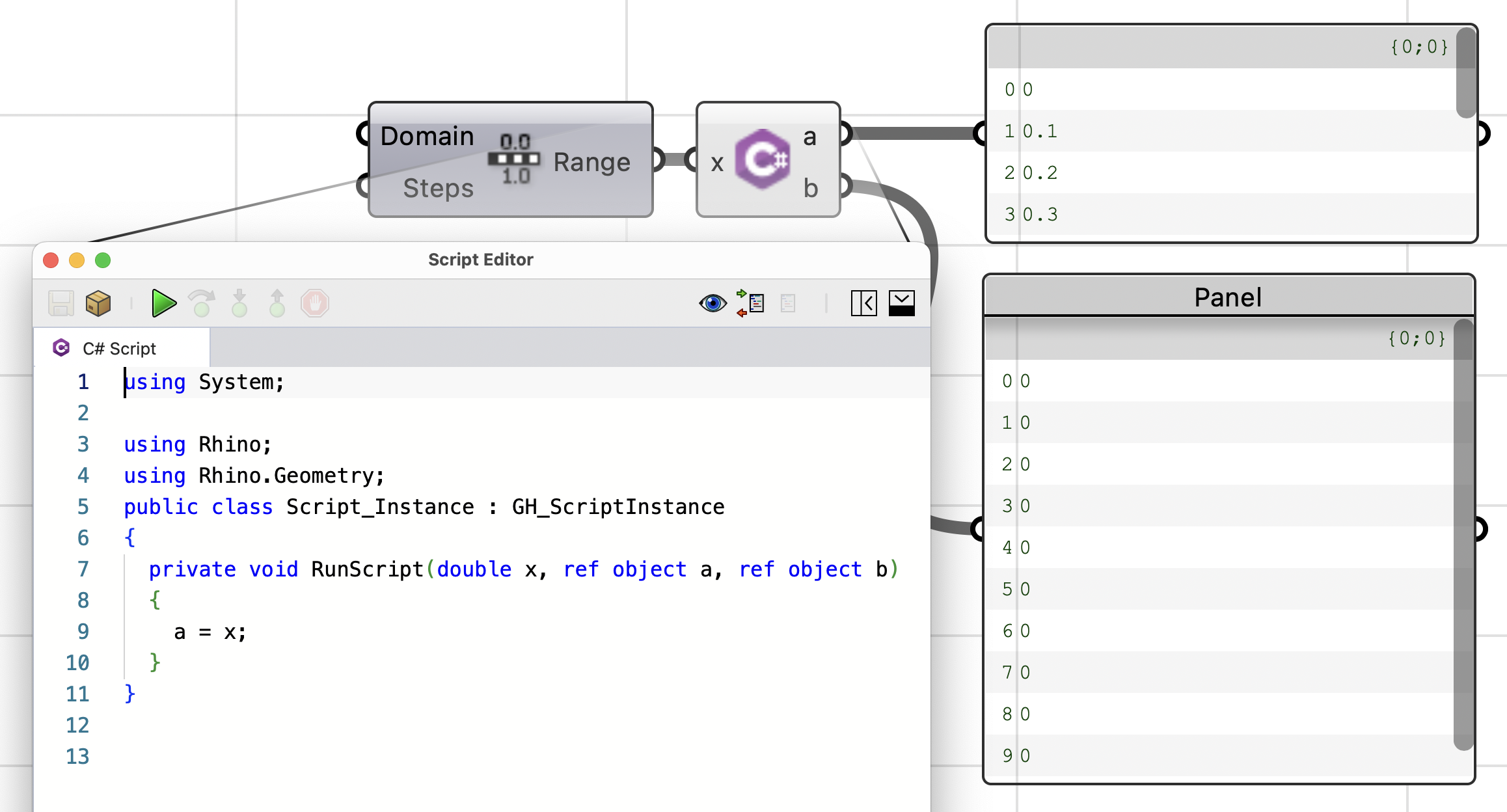
Keep this in mind when working with output Type Hints in C# script component.
Output Previews
Output parameters have their own individual Preview control. This option is on by default and Grasshopper renders previews for geometry values in output parameters:
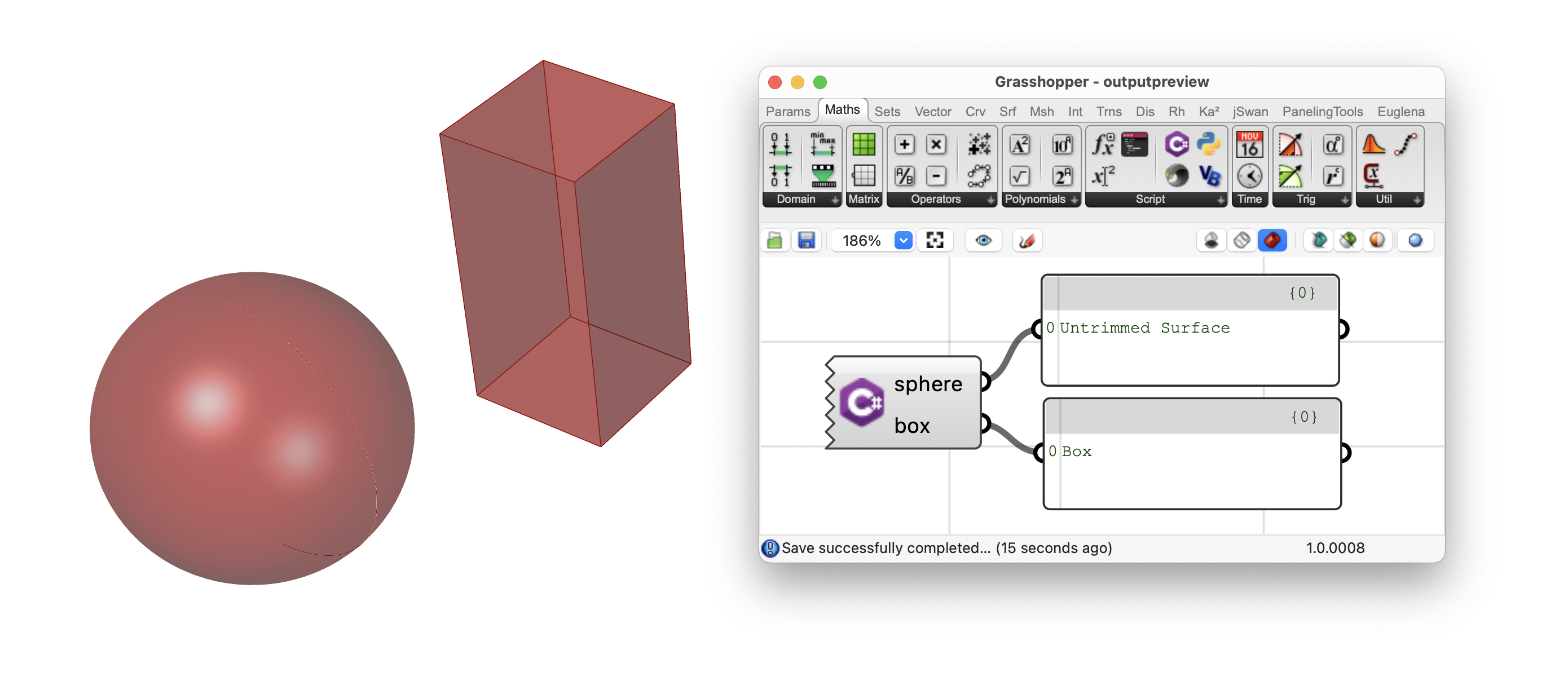
You can toggle this option off for any of the output parameters and hide the preview, using the Preview menu in the component context menu. Notice that the box preview does not show up while sphere is still previewed:
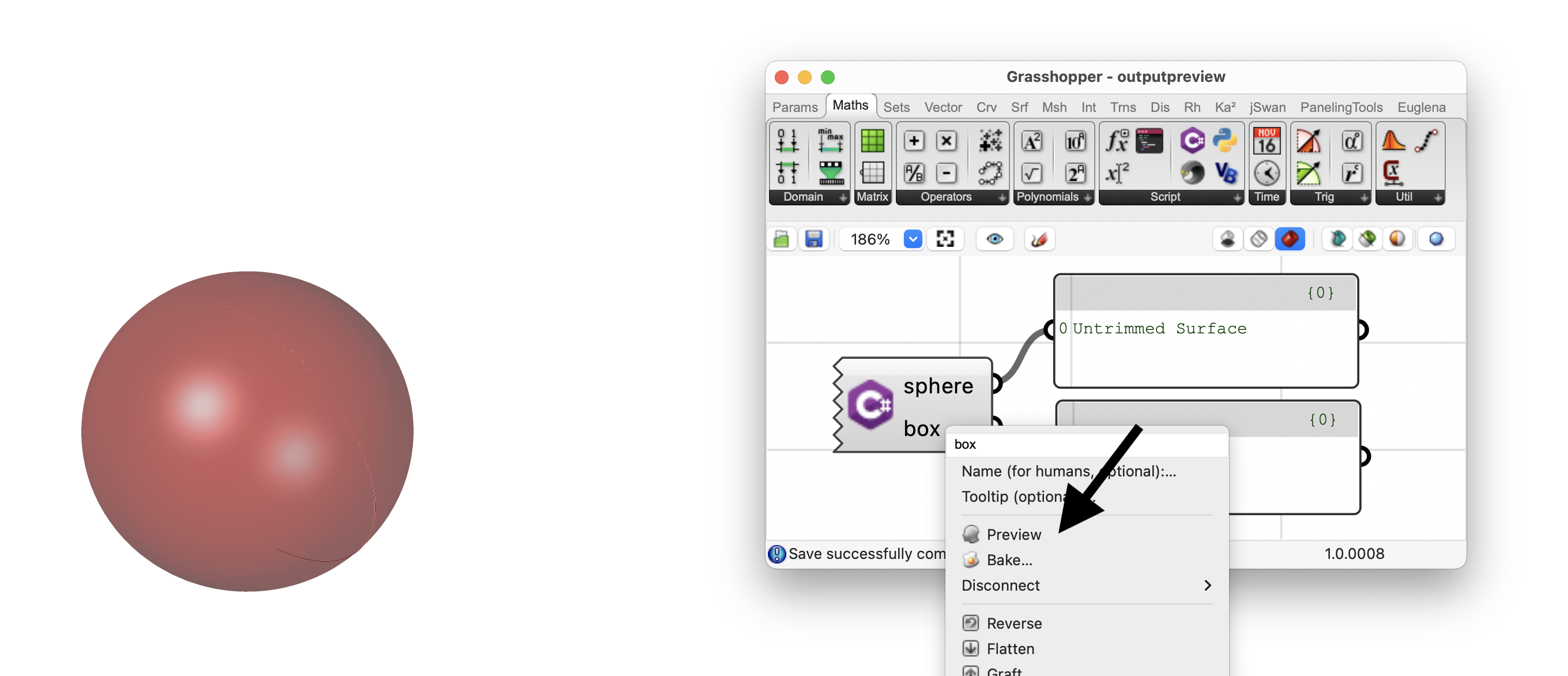
Exporting Script
You can save the script that is embedded in a C# script component, using the Export Script menu item from component context menu. When Save Dialog opens, choose a file name and location where you would like to save the script, and hit save.
Script Cache
C# script component compiles and caches the script, so it can execute faster when the script is not changed. Normally the cache is expired automatically when you make changes to the script or any of the parameters.
However, sometimes it is desired to expire the cache manually to ensure component is using a fresh build. To expire the compile cache, choose Discard Cache from component context menu.

